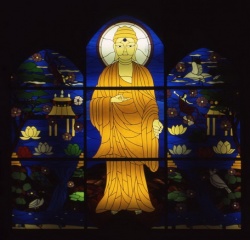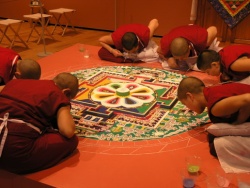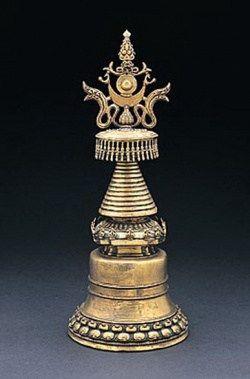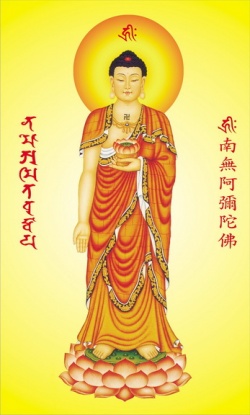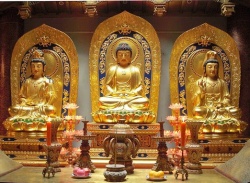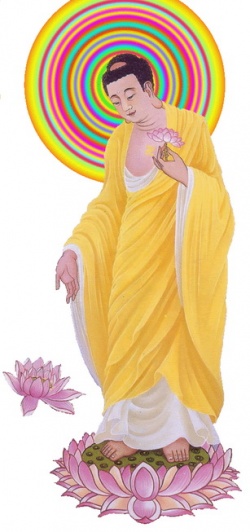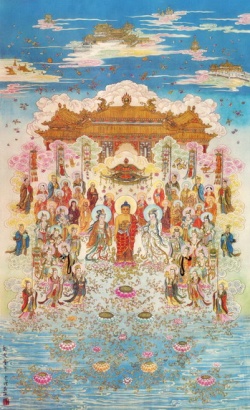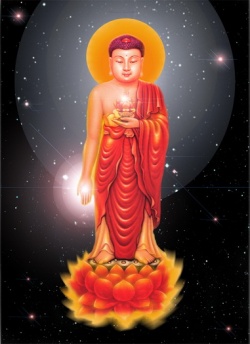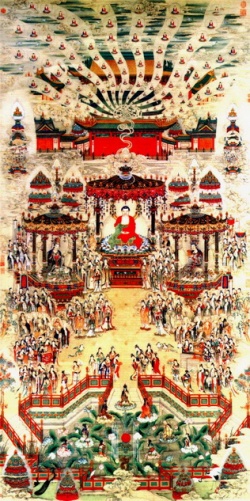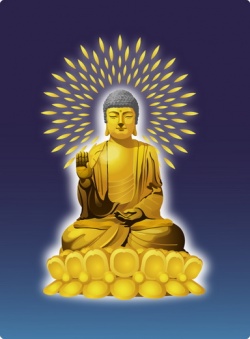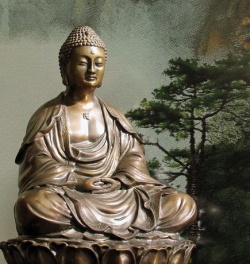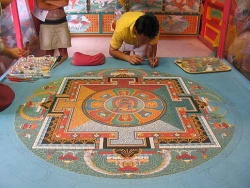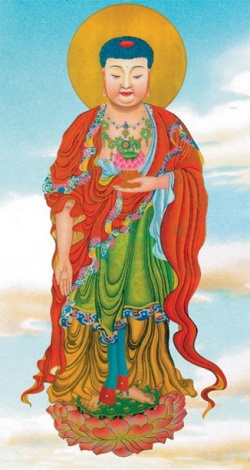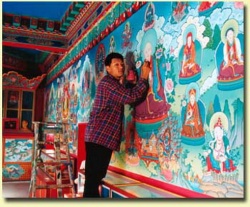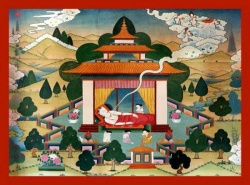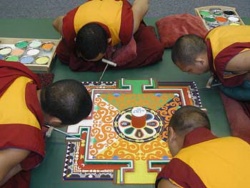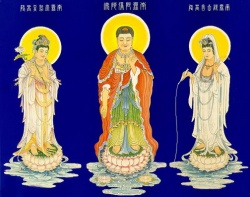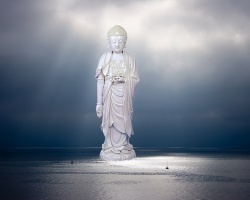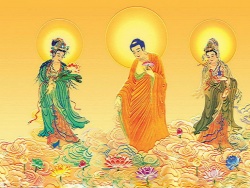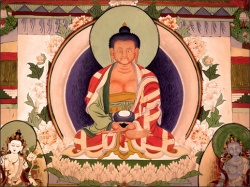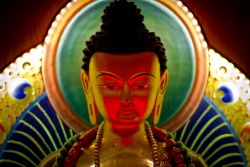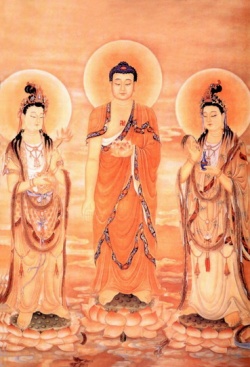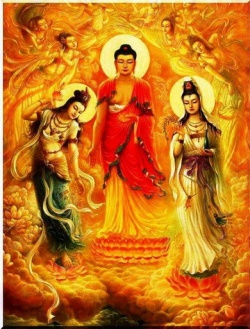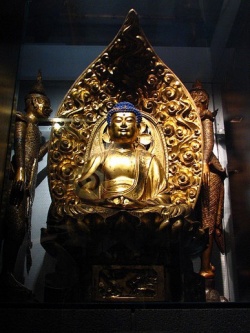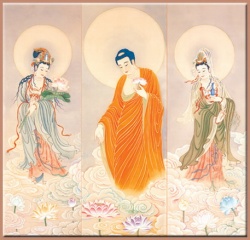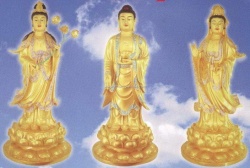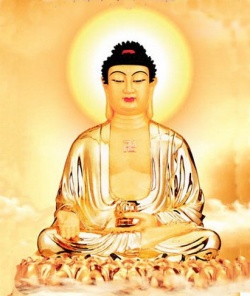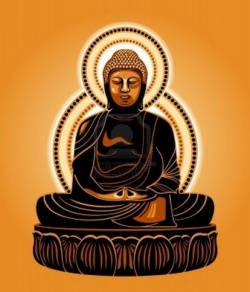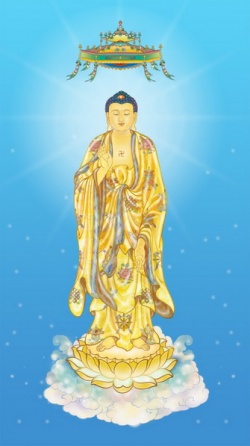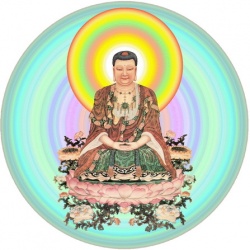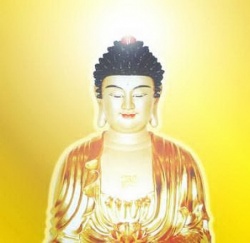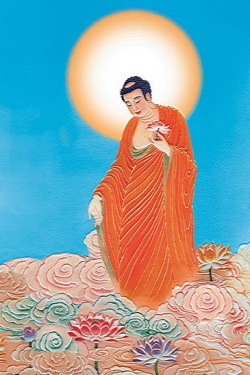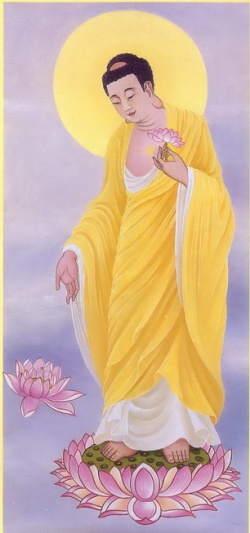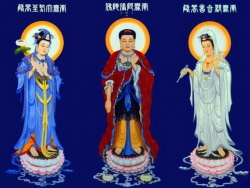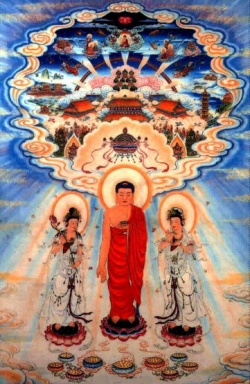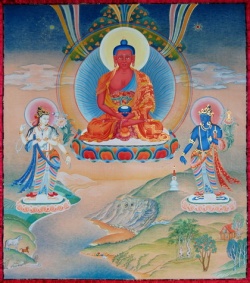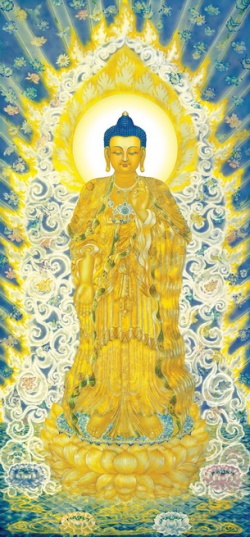A Study of the Concept of the Paccekabuddha in Pali Canonical and Commentarial Literature by Ria Kloppenborg
The Paccekabuddha:
A Buddhist Ascetic
A Study of the Concept of the Paccekabuddha
in Pali Canonical and Commentarial Literature
by
Ria Kloppenborg
Preface
The Paccekabuddha is an important figure in the Buddhist tradition who exemplifies the ascetic and introspective tendencies of the Buddhist and pre-Buddhist Indian heritage. Most of the textual references—canonical as well as commentarial—concerned with the Paccekabuddha relate the popular stories which describe the individual Paccekabodhisatta’s search for enlightenment, rather than elaborate on the doctrinal aspects of the phenomenon of the solitary enlightened one.
Therefore a systematic study of the place of the Paccekabuddha in Buddhist thought is stimulated less by the texts than by an attempt to uncover and convey the special reality of the individual’s choice for his own way towards liberation.
For me, this study has again emphasised the importance of the ancient ascetic, individualistic and world-rejecting tradition.
I wish to express my deep gratitude to the Venerable Nyanaponika Mahathera for his critical remarks and his friendly, unobtrusive guidance. I am indebted to Mrs. Helen Wilder’s efforts to select the passages from my original book as published by E. J. Brill, Leiden, in 1974, for this version in the Wheel Series, and to the publishers for their kind permission to revise and reprint the original work.
Introduction
The Paccekabuddha has received little detailed attention in the study of Buddhism. The most elaborate contributions are to be found in dictionaries and encyclopaedias. There an attempt has been made to establish his position among other enlightened individuals, as can be found in the systematic approaches of the Abhidhamma and commentarial texts, end to enumerate his basic characteristics. In this respect a short reference may be made to the articles in the Pali Text Society’s Dictionary where he is described as “one enlightened by himself, i.e., one who has attained to the supreme and perfect insight, but dies without proclaiming the truth to the world.” In Childers [1] he is thus described: “one who has attained, like a Buddha, by his unaided powers the knowledge necessary to Nirvana, but does not preach it to men … is not omniscient … in all respects inferior to a Sammasambuddho”; and Edgerton: “a Buddha for himself alone, who has won enlightenment but lives in solitude and does not reveal his knowledge to the world” (Buddhist Hybrid Sanskrit Dictionary).
To find an adequate English equivalent for the term Paccekabuddha (Sanskrit: Pratyekabuddha) is almost impossible, for, as is the case with many technical terms used in Buddhist texts, the word has various connotations and bears different shades of meaning. It has the meaning of: “one who is enlightened by himself, or for himself,” and also as “an enlightened one who is on his own.”
The term encompasses the basic characteristics of the type of person set forth in the explanations given in the canonical and commentarial literature, such as the fact of his solitary way towards enlightenment and his solitary way of life. One may be justified in saying that the rendering “an enlightened one who is on his own” accentuates the most typical characteristic. This fact is stressed over and over again in the literature, in narrative as well as in more systematic passages, especially when he is compared with a Sammasambuddha and an arahat. For “one who is enlightened by himself” can refer to a Paccekabuddha as well as to a Sammasambuddha.
The Paccekabuddha is rarely dealt with in the secondary literature. Most studies mention him as a possible type of enlightened personality recognised in the Canon, but go no further into the matter. The reason for this seems to lie in his lack of a sense of mission. As Eliot observes in his Hinduism and Buddhism: [2] “Their knowledge is confined to what is necessary for their own salvation and perfection. They are mentioned in the Nikayas as worthy of all respect, but are not prominent in either the earlier or later works, which is only natural, seeing that by their very definition they are self-centred and of little importance for mankind. The idea of a (Paccekabuddha) … is interesting, inasmuch as it implies that even when the four truths are not preached they still exist and can be discovered by anyone who makes the necessary mental and moral effort.”
The present study aims at filling in this gap with a detailed study of the concept of the Paccekabuddha. This study has been limited to the Theravada tradition and is mainly based upon the works incorporated in the Pali Canon and the main commentaries.
The Vinayapitaka gives no direct information on the subject, as its function is to provide rules of conduct for the monastic community. But since it also illuminates aspects of the organisation of the ascetic’s life and of ascetic communities, it can also shed some light on the way of life of the Paccekabuddha as this has been described in other scriptures.
The Suttapitaka, especially the Khuddaka-nikaya with its varied collection of works, contains many references to the concept of the Paccekabuddha. Among these, the forty-one verses of the Khaggavisanasutta of the Suttanipata are of major importance, as they are regarded as belonging to the most ancient ascetic tradition and the later development of a systematic classification of the different enlightened persons. The term Paccekabuddha itself is not used in the verses, perhaps because at the time the verses were composed, the concept of the Paccekabuddha in its technical sense had not yet been developed within the Buddhist system of thought. But the idea of a solitary ascetic seems clearly to be implied. The same observation can be made about other texts regarded as part of the older layer of Buddhist literature. In the works of the Abhidhamma-pitaka the Paccekabuddha is only mentioned in the systematic lists of persons who attain enlightenment, and no detailed information can be found.
Commencing in the 3rd century B.C. commentarial literature was written in Sri Lanka in Sinhalese. The commentaries continued to increase until at least the second century A.D., drawing new material from the Sinhalese Buddhist social and religious life. Buddhaghosa based his own systematised commentarial work on these older texts. Most of the information about the Paccekabuddha has been handed down to us by this scholar who drew upon the living tradition of the previous centuries.
The concept of the Paccekabuddha underwent further developments in the Mahayana schools of Buddhism, but these lie beyond the scope of the present work.
The adaptation of the concept of the Paccekabuddha in Buddhism seems to have been inspired by the Indian tradition of asceticism and individualism, and the popular reverence and esteem for ascetics, wandering religious men, munis and sages.
Since the earliest times, ascetics who leave society to evade the hindrances of worldly ties and to search for insight into reality and salvation have been mentioned as one of the most typical characteristics of Indian religions. The Rg-Veda mentions a class of holy men distinct from the brahmins, the munis who are said to possess supernatural powers, especially the ability to fly through the air and to read other people’s thoughts. This asceticism seems to have developed among different groups or individuals along a similar line, and shows similar characteristics of practise and circumstances: a solitary life outside the community, residence in forests or on the outskirts of towns and villages, dressing in clothes of bark or of rags, living on begged food or plants, shaving the hair, etc. Some of these ascetics lived in isolation, others in groups; still others wandered in groups or alone, begging for alms, preaching their doctrines to those who wished to listen. The fact that there are only a few references to these ascetics in Vedic literature does not imply that they were rare. They formed a religious group distinct from the orthodox sacrificial priests and developed their own culture and style of living. Many of the impulses for new developments in thought came from these groups.
The motives for abandoning society in the search for final release were based on the belief that life formed an endless chain of existence from which deliverance was necessary. The sense of freedom from worldly cares and ties has been one of the main themes in the religious literature of India, Hindu and Buddhist.
The acquisition of supernatural powers is often mentioned as another motive for asceticism. Throughout the entire literature it is stated that one of the main aims of the Indian ascetic is the acquisition of powers to control the course of nature. These powers, gained through ascetic practices, offered the opportunity to rise above the brahmanical sacrificial priest, not only on the level of spiritual development, but also on the material plane. Consequently, the ascetics were honored, respected and even feared by the people. The ascetics who achieved their goals were more powerful than any other persons in the universe; even the gods were subordinate to them.
The tradition of asceticism and the idea that release could only be attained by the individual, seems to have reached its culmination in the time of the Buddha. During that period numerous groups of ascetics appeared, living alone or following a leader, dwelling in forests or wandering as mendicants. The idea prevailed that escape from rebirth and salvation could only be obtained by renunciation of the ordinary societal ties in favour of a special way of life. In this period the ancient tradition of munis and sramanas found new continuity and a suitable soil for new developments in Buddhism and Jainism, which were both ascetic in making renunciation of life in the world essential for release and in continuing the tradition of the individual attainment of enlightenment.
Although the Buddha rejected austere asceticism and the practice of ritual in the way these were followed by the sramanas (ascetics; Pali: samanas) of his time, and favored a less rigid separation from society for his monks, his teaching exemplified the main traits of the Indian ascetic contemplative tradition: a stress on renunciation, entrance upon religious life, and solitary meditation as important aids to the attainment of insight. Most of the monks chose to live within the communal structure of the Order, and to combine their meditative practise with such tasks as preaching, teaching, study, discussion, and social activities. But there were some monks who preferred to follow the older ideal of the solitary recluse, remaining bound to the community only by means of the fortnightly uposatha-celebration, [3] at which the rules of the Order were recited. In the early Buddhist community the thera Mahakassapa was especially esteemed for this type of austerity. Those who followed the Buddha’s Path in this personal way continued the ancient tradition of asceticism and were respected and honoured by the people on the same level as were the munis, sramanas end other ascetics. Later, in Sri Lanka, the monks who lived in the forests became a separate group, the Vanavasi-nikaya.
The concept of the Paccekabuddha presented the opportunity to include pre-Buddhist recluses and seers in Buddhism and in doing so it continued these pre-Buddhist traditions. In this respect it becomes clear why Paccekabuddhas are referred to in the scriptures with all other terms that could be used to denote ascetics: muni, isi, samana, tapasa, jatila, terms which emphasise different aspects of asceticism.
In order to find a legitimate place within Buddhist teaching, these ascetics had to fit in with the system of thought. They were given their place as a way of recognizing that the Dhamma, the eternal and highest truth, is always accessible and can be attained by those of great virtue and spiritual maturity even when the formulated Dhamma of a Buddha is not available. For the Dhamma, as the formulated teaching, is subject to the law of origination, growth, and decay. It appears in history, revealed by a Buddha, and for a period is studied, practised, and taught by human beings. But these periods during which the Dhamma is known alternates with other periods during which it has disappeared, remaining only on the level of absolute truth. This does not mean, however, that the truth cannot be attained during this time. It only means that the truth must be personally discovered without the guidance of an articulated doctrine and map of the path, an achievement calling for a very highly developed faculty of wisdom.
Those who discover the Dhamma by themselves are of two types: the Sammasambuddha, who, after realising the Dhamma, teaches it in its fullness and re-establishes the dispensation in the world; and the Paccekabuddha, who does not reveal it or preach it to the great mass of people. To proclaim the Dhamma anew requires special qualities—omniscience and supreme compassion—and even then the decision to reveal the abstruse, ultimate truth is difficult to make. The figure of the Paccekabuddha provided the means to accommodate the notion of one who discovers the truth for himself without possessing all the powers of a supreme Buddha, and thus chooses not to try to teach the truth at large. This same figure also serves to confirm the validity of the achievements of ascetics and sages of pre-Buddhist times.
With the emergence of ideas which finally took shape in the Mahayana schools, the ideals of the Pratyekabuddha and of the arahat came to stand for what was called ”the Hinayana.” In contrast to the individualistic outlook of the earlier schools, the Mahayanists, challenged by what seemed to them self-centredness, felt that it was impossible for any enlightened being not to teach to others the truth he had discovered. The change of view caused a different attitude towards the arahat and the Pratyekabuddha. They were now considered egoists, and contrasted unfavourably with the Bodhisattva, whose dedication was praised. Another change which took place concerned the conception of time. The phenomenal world was no longer regarded as proceeding in time, but as operating idealistically. Therefore Buddhas were no longer conceived as following one another in time, as historical persons, but as manifesting themselves in this world spontaneously. The concept of Buddhahood was no longer directly connected with an historical figure, but considered as the ultimate goal for all, the germ of Buddhahood being present in every person. This outlook made the concept of Pratyekabuddha a mere possibility of the older schools. and deprived it of its historical reality within the tradition of Indian religiosity.
However as it was impossible to negate the concept, attempts were made to make it fit in with the new ideas. A discussion started as to whether there was any difference between the goals of the sravaka and the Pratyekabuddha on the one hand, and of the Bodhisattva on the other. Their Ways were different, but did this also result in different goals, in a different Enlightenment and Nirvana?
This question resulted in the diverse opinions of the Mahayanist philosophers regarding the three vehicles and the one vehicle, their distinctions and similarities.
Although it is not the intention of this paper to treat the concept of the Pratyekabuddha as it occurs in the Mahayana schools, a few fundamental differences between the Mahayana and Theravada conceptions should be mentioned.
The idea that the three yanas lead to their own specific Bodhi and Nirvana, as is found in the Samdhinirmocanasutra and the Mahayanasutralamkara, and the idea that sravaka and Pratyekabuddha (dviyana) on the one hand and Bodhisattva (ekayana) on the other attain distinctive goals, as it can be found in the Lankavatarasutra and most of the Madhyamika and Yogacara works, were both refuted by other Mahayanists. They postulated that there can be only one vehicle (ekayana) since there is only one insight. This view has been expressed in the Saddharmapundarika thus: “The venerable Mahakasyapa asked: ’If, O Lord, there are no three vehicles, for what reason has one at the present period formed the conception of disciples, Pratyekabuddhas and Buddhas?’ Being thus addressed, the Lord said to the venerable Mahakasyapa: ’A potter makes many vessels out of the same clay. Some of them hold sugar, others ghee, others curd and milk, and others again impure waste matter. There is no difference in the clay, but only in the substances which are put in the resulting pots. Just so, O Kasyapa, there is just this one single Buddha-vehicle, and a second or third vehicle does not exist.’ Being thus addressed the venerable Mahakasyapa said to the Lord: ’But if, O Lord, those beings who have found their way out of the threefold world, have different dispositions, will their nirvana be one, two or three?’ The Lord said: ’Nirvana results from understanding the sameness of all dharmas. Hence there is but one nirvana, not two or three”’ (132 f.).
In this connection no separate existence is allotted to the sravaka—and Pratyekabuddha—vehicles. To attain Bodhi and Nirvana one has to follow the ekayana, the only way of the Bodhisattva. However, in many Mahayana works distinctions are made between the sravaka, Pratyekabuddha, and the Bodhisattva. The most important of these is the fact that sravakas and Pratyekabuddhas are said to be capable of purifying only the hindrance of the defilements (klesavarana) and not the hindrance of the knowable, the intellectual faults (jñeyavarana), while Bodhisattvas are said to purify both hindrances. The wisdom and knowledge of a Pratyekabuddha is very small compared to the wisdom of a Buddha: “If the ten points of space were filled with Pratyekabuddhas, free from faults, gifted with acute faculties and standing, in the last stage of their existences, as numerous as reeds and bamboos in the woods; and if combined for an endless number of myriads of kotis of Aeons, they were to investigate a part only of my superior laws, they would never find out its real meaning” (Saddharmapundarika 32, vs. II, 12–13).
Some Mahayana works differentiate between the sravaka and the Pratyekabuddha by asserting that the former attains insight through meditation on the four noble truths, the latter through meditation on dependent origination (pratityasamutpada). This idea gave rise to the use of the term Pratyayabuddha, “one who has become enlightened by (understanding) the causes,” for “by a thorough insight into causes and conditions (hetupratyaya) they hope to win final nirvana for themselves” (Saddharmapundarika III 80, 9). In Chinese and Tibetan translations this aspect has been given much attention, because in Tibetan the Pratyekabuddha is often referred to as “one who meditates on pratitya” (rten-’brel-bsgom), “who understands only the causes” (rkyen-gcig-rtogs), Reverence paid to Pratyekabuddhas remained, also in Mahayana surroundings, a means of acquiring merit; it has even been recommended by rulers in their edicts.
The Paccekabuddha
The Apadana of the Khuddakanikaya belongs to the later works of the Pali Tipitaka and consists of a collection of stories in verse in which the instructive life-histories (apadana) of saints and arahats have been related. The second section deals with the Paccekabuddha apadana. In it the Khaggavisanasutta of the Suttanipata has been inserted. Here the beginning and the concluding verses are given in translation.
1. The muni Vedeha, bowing his body, asked the Tathagata, who was staying in the Jetavana: ”Paccekabuddhas are said to exist, by what reasons do they become wise?”
2. Then the best of the omniscient, the great wise one, said to Anandabhadda (”Ananda, the virtuous”) in a sweet voice: ”Those who have fulfilled their duties under all (former) Buddhas, without attaining liberation during the period in which the teaching of the Jinas is known.
3. “Who are wise because of their repulsion, [4] whose wisdom is very sharp, who attain insight by themselves even by means of a small object of meditation without the instruction of Buddhas.
4. “And what is more, in this whole world, there is no one except me equal to the Paccekabuddhas. I shall clearly express the following, only an abridged description of the distinction of the great munis.
5. “Listen, all of you, who wish for the highest medicine, your thoughts very calm, to the good words which are sweet like honey, of those great wise men, who are fully enlightened by themselves.
6. “To these expositions of Paccekabuddhas, who assembled (on Mount Gandhamadana), pronounced one after the other about the wretchedness and the cause of the absence of passion, and how they attained insight.
7. “Their consciousness without passion with regard to the objects of passion, their minds dispassionate in an impassionate world, having abandoned the world of conceptualisation (papañca). The agitations conquered (by them), thus they attained insight.
8. “Putting aside violence to all beings, not hurting any of them, good and compassionate, with a mind filled with friendliness, one should live alone, like the horn of a rhinoceros,
(Here follow the forty-one verses of the Khaggavisanasutta of the Suttanipata)
50. “Their morality pure, their wisdom purified, concentrated, practicing watchfulness, contemplating, seeing the characteristics of the dhamma, they understand, having gone through the Path factors of the way [5] and the elements of enlightenment. [6]
51. “Having practiced the aspiration regarding the attainment of merit, which is thus characterized, they do not attain the state of a disciple during the Jina’s teaching, (but) they become Paccekajinas, self-existent and wise.
52. “Their dhamma is great, their many bodies are according to the dhamma, they are masters of their Minds, they have overcome the flood of all sufferings, their minds exalted, they have seen the highest truth, like lions are they, like the horn of a rhinoceros.
53. “With serene senses, calm, concentrated, practicing mindfulness with regard to the people of border districts, illuminating like lamps in the other world and in this world, thus are these Paccekabuddhas, always good.
54. “Having destroyed all hindrances, kings of men, illuminators of the world, shining like solid gold, undoubtedly worthy of gifts in the world, are these Paccekabuddhas, always good.
55. “These are in this world together with the world of the gods the good words of Paccekabuddhas. Those fools who, having heard them, do not act accordingly, whirl round in sufferings again and again.
56. “Those who, having heard the good words of the Paccekabuddhas, which are like a sweet stream of honey, act accordingly, become seers of the truth, possessing wisdom.
57. “These excellent verses have been spoken by the Paccekabuddhas, the conquerors, after they had gone forth, and they have been made known by the Lion of the Sakyas, the highest of men, for the sake of the understanding of the Dhamma.”
58. Out of compassion for the world these miraculous deeds of these Paccekabuddhas have been made known by the Lion of the self-existent ones, in order to increase (the number of) those who are victorious in battle because of their repulsion (Ap I 7–14).
I. 1. His Position, Compared With the Sammasambuddha and the Savaka
The Commentary on the Khuddakapatha gives an exposition of the classes of living beings and classifies them from the lower to the higher stages of existence.
Human beings are divided into women and men. The men are further classified into those who are householders and those who have left their houses, the anagarika. The anagarika are divided into ordinary people (puthujjana) and noble ones (ariya). The ariya are again classified into those who need further instruction (sekha) and those who do not need further instruction (asekha, i.e., the arahats). These are divided into those who, in their prior practise went the way of pure insight (sukkhavipassaka) and those who had started with the practice of quietude (samathayanika). The samathayanika are divided into those who have not attained the perfections of a disciple (savaka) and those who have. Then follow the Paccekabuddhas, who are called higher than the disciples because of the greatness of their virtue. “Even several hundreds of disciples who are like Sariputta and Moggallana do not attain a hundredth part of the virtues, of one Paccekabuddha.”
Higher than the Paccekabuddhas are the Sammasambuddhas because of the greatness of their virtue: “For even (a group of) Paccekabuddhas seated on the whole of the (continent of) Jambudipa so close together that sitting cross-legged (their knees) would touch each other, do not attain a portion, or a sixteenth part or a small fraction (of that) of the virtues of one perfectly enlightened one” (I 177–178).
A hierarchy is clearly evident from this passage: The Paccekabuddhas are higher than the perfected disciples, and the perfect Buddhas are ranked above the Paccekabuddhas. These three groups are often mentioned together, e.g. in connection with their common attainments and way of life. In this section we shall mainly emphasise their differences.
The Puggalapaññatti enumerates nine individuals, first the Sammasambuddha, secondly the Paccekabuddha, thirdly the savaka, etc. The first two are distinguished as follows: “What individual is the Sammasambuddha? In this world a certain individual awakes by himself to the truths among teachings that are not heard of before and then attains omniscience (sabbaññuta) and mastery of the powers (bala); this individual is called a Sammasambuddha.
“What individual is the Paccekabuddha? To this world a certain individual awakes by himself to the truths among teachings that are not heard of before and then he does not attain omniscience or mastery of the powers; this individual is called a Paccekabuddha” (Pug 10).
So the Paccekabuddha attains enlightenment, but not the omniscience or the powers which are the special attainments of the Sammasambuddha.
There are more points of difference. In the Milindapañha (“The Questions of Milinda”) the thoughts of various classes of beings are classified. The sevenfold classification consists of the ordinary person, the person who has entered the stream (sotapanna), who is to be born once more (sakadagamin), who will not be reborn in the world of the senses (anagamin), the arahat, the Paccekabuddha and the Sammasambuddha. The text says:
“The arahats, o great king, whose evil Influences (asava) have been annihilated, whose stains have been washed away, whose defilements have been left behind, who have reached perfection, who have attained the highest good, who have destroyed the bonds of existence, who have attained mastership in analysis (patisambhida), are pure on the stages of the savaka. In the province of the savaka their thoughts arise lightly and move lightly, (but) on the stages of the Pacceka-buddha they arise with difficulty and move sluggishly. And why? Because they have been fully purified in the province of the savaka and because they have not been fully purified in the province of the Paccekabuddha” (Mil 101).
And about the thoughts of the Paccekabuddha:
“Those Paccekabuddhas, O great king, are self-existent (sayambhu), without a teacher, living solitarily (ekacari), resembling the horn of a rhinoceros, in their own province possessing thoughts which are pure and stainless; in their own province their thoughts arise lightly and move lightly, (but) on the stages of the omniscient Buddha they arise with difficulty and move sluggishly. And why? Because they have been fully purified in their own province and because of the greatness of the province of the omniscient Buddha.
“It is, O great king, like a man who on his own land might cross a small river by night or by day, whenever he wants, without fear, but who might be afraid, might tarry and might not dare to cross the great ocean, having seen that it is deep, wide and unfathomable, and with no other shore in sight, and why? Because of the familiarity with his own land and of the greatness of the great ocean” (Mil 105).
The distinctions regarding the families in which they are born are described in the Suttanipata Commentary where it is said: “Having fulfilled the perfections, when (future) Buddhas are reborn in the world, they are born in a family of khattiyas, brahmanas or householders; and chief disciples, like Buddhas, are also born in families of khattiyas or brahmanas” (Sn-a 51).
It is noteworthy that in this passage future Buddhas and chief disciples are described as being born in the same kinds of families, and that future Paccekabuddhas are also born in families of householders, i.e., apparently socially lower classes than those of the khattiyas and brahmanas.
The text continues: “perfect Buddhas do not arise in the world period of devolution, but they arise in the world period of evolution, Paccekabuddhas arise without having come to know Buddhas and not at the times of the birth of a Buddha.”
Here the important fact of the Paccekabuddha’s period of appearance is mentioned. Only in times in which there are no Buddhas, is it possible to attain Paccekabuddhahood.
And further: “Buddhas are enlightened by themselves and enlighten others: Paccekabuddhas are enlightened by themselves (but) do not enlighten others: they comprehend only the essence of meaning (attharasa), not the essence of the idea (dhammarasa). Because they are not able to put the supramundane dhamma into concepts and teach it; their realization of the Dhamma is like a dream seen by a dumb man and like the taste of a curry from the city to one who lives in the forest; they reach the whole that consists of supernatural power (iddhi), attainments (samapatti) and analysis (patisambhida).
As to the eminence of their virtues they are lower than Buddhas and higher than disciples; making others enter upon the religious life they teach the practise of lesser ethics (abhisamacarika) [7] with this instruction: ”Austerity regarding the mind should be practised, perfection should not fall into stagnation.”
All the principal points of difference between Buddhas and Paccekabuddhas are mentioned here: Paccekabuddhas usually do not bring others to enlightenment; they do not understand the full range of the dhamma; they are not able to formulate it by way of concepts, They possess supernatural powers, reach high levels of meditation, and can influence others indirectly to take up a religious life.
The commentary continues: “They announce uposatha saying: ’Today is uposatha’, or with a similar saying. And having announced uposatha they celebrate (it) after having gathered on (Mount) Gandhamadana at the root of the Mañjusaka tree in the Jewel-Yard.”
A distinction between the knowledge (ñana) of disciple, Paccekabuddha and Buddha is made in the Saratthappakasini, where the Buddha is shown admonishing Ananda thus: “Why did you not penetrate the knowledge of the perfections of a disciple like Sariputta and Moggallana, who fulfilled the perfections in the course of one hundred thousand kalpas plus one incalculable period, and (why) did you not penetrate the knowledge of self-enlightenment like the Paccekabuddhas who fulfilled the perfections in the course of one hundred thousand kalpas plus two incalculable periods?” (S-a II 93).
Buddhaghosa’s commentary on the Dighanikaya describes three different categories of knowledge as follows: “The knowledge of the perfections of a disciple is deep, (but) therein is no determination (vavatthana). And further the knowledge of a Paccekabuddha is deeper than that, (but) also in that there is no determination. And the knowledge of omniscience is deeper than that. And there is no other that is deeper …” (D-a I 100).
And in the Saratthappakasini “Disciples … attain the knowledge of the perfections of a disciple, Paccekabuddhas the knowledge of self-enlightenment, (and) Buddhas the knowledge of omniscience” (S-a III 208). The Majjhimanikaya enumerates fourteen offerings graded according to the state of the individual to whom they are presented: the first is the offering presented to a Sammasambuddha; the second the offering presented to a Paccekabuddha, the third to an arahat-disciple of a Buddha (M III 254).
In addition to the classification of Buddha, Paccekabuddha and disciple, another classification occurring in the commentarial literature speaks of four kinds of Buddhas: the omniscient Buddha, the Paccekabuddha, the four-truths Buddha, and the learned Buddha (S-a I 25). These are explained as follows: “Here (the person) who, having fulfilled all the thirty perfections, [8] attains perfect enlightenment, is called an omniscient Buddha. (He), who, having fulfilled the perfections in the course of one hundred thousand kalpas plus two incalculable periods, attains the state of a self-existent one, is called a Paccekabuddha. The remaining ones who have destroyed the evil influences are called four-truths-Buddhas. And those who are very learned (are called) learned Buddhas” (S-a I 25). In this classification the third member of the threefold series, the disciple, has been divided into the liberated disciple or arahat and the disciple who is learned in the teaching but not yet liberated.
Besides the differences between Buddhas, Paccekabuddhas, and disciples according to the technical use of the terms, certain shared similarities can also be found in the texts. Thus Buddhas, Paccekabuddhas and disciples are equally called noble (ariya), and their lineage is the lineage of the noble (ariyavamsa).
Four persons are called worthy of a stupa, namely a Sammasambuddha, a Paccekabuddha, a disciple, and a king who is a world-ruler. The function of a stupa of a Paccekabuddha is that “having made their hearts confident, thinking: ”This is the stupa of a Lord Paccekasambuddha,” (people) attain a good form of existence, a heavenly world, on the dissolution of their bodies at death.”
The Kathavatthu states that Paccekabuddhas, Sammasambuddhas and disciples cannot arise in the world of the gods, because among the gods there is no one who follows a religious life. They can only arise in the human world where a religious life, i.e., a life of renunciation and meditation, is possible (Kv I 95 and 97). Although Buddhas, Paccekabuddhas, and disciples live in the world of sensual desire, they do not remain subject to the five strands of sensual pleasures.
Mara is mentioned in references to Buddhas as well as to Paccekabuddhas. Both are said to have conquered the evil one and his army. Towards both Mara sometimes plays the role of the offended king of evil, who, by means of sly tricks, tries to embitter the life of his conqueror. One example is the following well-known story, which is told about the Buddha as well as a Paccekabuddha: “In a time in which no Buddha existed … one Paccekabuddha entered the city for alms. Because Mara had beguiled all the citizens, he did not receive any offering of alms and went away with an empty bowl. Then Mara, having gone to the city-gate, stood there in disguise, and asked the Paccekabuddha when he arrived: ’Reverend Sir, did you not receive anything?’—’Are you not the cause I did not receive anything?’—’Then turn back and enter (the city) again; now I shall cause (you to receive alms):—’I shall not turn back again.’ For, if he had turned back, (Mara) would have again entered into the bodies of all the citizens, hit (him) with his band, and ridiculed him” (Dhp-a I 2, 196).
An interesting relationship occurs between a (future) Buddha and a Paccekabuddha when they are disciple and teacher in a former existence. A future Paccekabuddha is often mentioned as a disciple of a Buddha during one of his former existences. Not being able to reach arahatship at that time, he eventually attains Paccekabodhi. Examples of the reverse relationship are also be found in the Jatakas, where it is told that the future Buddha Sakyamuni received advice and help from Paccekabuddhas on his way to enlightenment. In the following fragment from the Pañcuposathajataka, a Paccekabuddha assists the Bodhisatta (then an ascetic) to overcome the pride which prevents him from attaining jhana:
“Then one Paccekabuddha, perceiving that he (the future Buddha) was possessed with pride, (thought): This no common being, he is destined to be a Buddha; even in this world-period he will attain omniscience. Having made him subdue his pride I shall cause him to develop attainments (samapatti). Then he left the northern Himalayas. While the ascetic was seated in his hut, the Paccekabuddha sat down on his slab of stone. Coming out of his hut the ascetic saw him seated on his own seat and because of his pride could no longer control himself. He went towards the Paccekabuddha and snapped his fingers, saying: ’Fall dead, you vile, black-eared, bald-headed little ascetic, why are you sitting on my stone seat?’ And the Paccekabuddha said to him: ’Good man, why are you possessed with pride? I am one who has penetrated the knowledge of Paccekabodhi, (and) even this world period you will become an omniscient Buddha, you are destined to be a Buddha. When you have fulfilled the perfections, and when another world period like this has come, you will be a Buddha. In this state of Buddhahood you will be named Siddhattha.’ He depicted everything to him, name, family, clan, chief disciples etc. saying: ’Why are you so rough, out of pride? Such a thing is unworthy of you!’ and he gave him advice. Even being addressed by him in this way the ascetic did not honour him nor ask: ’When shall I be a Buddha?’ and other things. Then the Paccekabuddha said to him: ’Know the difference between your greatness based upon your birth and mine based upon my virtues: if you can, move in the air like me!’ He then rose up into the air and, shaking off the dust of his feet on (the ascetic’s) tuft of hair, he went to the northern Himalayas. After this admonition the ascetic was overcome with grief and having fulfilled several observances, reached the brahmaloka.” (J-a IV, 328)
I.2. His Outward Appearance
There are several references in the texts to the outward appearance of the Paccekabuddha. Generally he is depicted as an ascetic or wandering monk. In some places his appearance is described with more details, as in Jataka IV 114:
“(With) their hair two fingerbreadths (angula) long, wearing yellow robes, they live in the northern Himalayas on the Nandamulaka-slope … A red double cloth was wrapped (around him), a girdle which looked like a flash of lightning was tied (around him), an upper robe and mantle with the colour of pink lac was hanging over one shoulder, a ragged robe with the colour of a storm-cloud was draped over the (other) shoulder and an earthen howl of bee-brown colour dangled at his left side.”
From this description we learn that the Paccekabuddha was thought of as having the same clothes and attributes as the Buddhist monk or the wandering ascetic: the shortcut or shaven hair, the three robes made of raga and dyed in red-brown colours, the bowl, etc.
The Anguttara Commentary says: “Paccekabuddhas … have (their) hair and beards two fingerbreadths long and have the eight requisites fastened round their bodies” (A-a I 354).
And the Sutta-Nipata Commentary relates in similar words: “And he touched his head with his right hand: at once the characteristics of a householder disappeared, and the appearance of one who has undertaken a religious life became manifest; his hair and beard were two fingerbreadths long; he was provided with the eight requisites and looked like a senior monk a hundred years old” (Sn-a 63).
As was customary in the case of monks and ascetics, Paccekabuddhas were also presented with the requisites of an ascetic (samanaparibhoga), namely the three robes, bowl, razor, needle, girdle and water-strainer.
The fact that the Paccekabuddha is described as having the outward appearance of a monk—the only difference being the usually short-cut hair and beard of the Paccekabuddha, in contrast to the shaven hair and beard of the monk—sheds some light on the problem of why images or representations of Paccekabuddhas are so strikingly rare in Buddhist art. Most probably representations of Paccekabuddhas were made, but they cannot be distinguished from those of monks unless an inscription shows them to be indeed images of Paccekabuddhas.
I. 3. Names and Individuals
The Majjhima Nikaya (M III 69–71) enumerates 119 names of a group of five hundred Paccekabuddhas who are said to reside on Mount Isigili. Of these names only a few are mentioned in Pali texts elsewhere: the most important ones are Tagarasikhin, Uparittha, Matanga and Mahapaduma. The Paccekabuddha Uparittha occurs in a story in the Manorathapurani where he plays a role in one of the previous existences of the Buddha’s cousin Anuruddha, who, as the poor Annabhara, presents him with alms. “Then one day on Mount Gandhamadana, the Paccekabuddha named Uparittha, having entered the attainment of suppression (nirodhasamapatti), came out of this (meditation) and reflected: ’To whom ought compassion be shown today?’ For Paccekabuddhas are compassionate towards those who have entered a bad form of existence.” Having chosen Annabhara as a suitable object for his compassion, he went to him to receive alms. Then Annabhara filled the Paccekabuddha’s bowl with his own meal and presented him with it, expressing the wish to be released from his miserable existence, and he then made the Paccekabuddha sit down upon his own cloak to eat (A-a I 185).
The same text mentions the Paccekabuddha Mahapaduma, the first of the five hundred Paccekabuddhas who are the sons of Padumavati. He is the only one who is said to have been born from her womb, the others having been born from moisture. He is the first of the group to enter Nibbana.
Tagarasikhin is the most frequently mentioned Paccekabuddha. He is the third son of Padumavati and lives on Mount Gandhamadana ”in the happiness resulting from the attainment of the fruit.” Tagarasikhin is mentioned in the Udana, where he is insulted by the son of the wealthy merchant, named Suppabuddha, who called him a leper. As a result of this offence Suppabuddha was reborn in hell and remained there for many hundreds of thousands of years, after which he obtained a human existence as a leper. In one of the Jatakas Tagarasikhin figures in a story in which he receives a gift from an unbeliever, who regrets his generosity afterwards.
Padumavati, the mother of the five hundred Paccekabuddhas, is regarded as a previous incarnation of the nun Uppalavanna. How she acquired the merit which enabled her to attain this state is explained in the following fragment from the Manoratha-purani (A-a I 346): “At that time one Paccekabuddha, having come out of the attainment of suppression on Mount Gandhamadana went to a place not far from where she was and stood (there). Having seen the Paccekabuddha, she took fried grain and a lotus-flower, came down from her car, and threw the fried grain into the Paccekabuddha’s bowl. Having covered the bowl with the lotus-flower, she gave (it to him). Shortly after the Paccekabuddha had left she thought; ’Those who have entered upon religious life have no need of a flower; I shall adorn myself with the flower.’ She went (to him) and took the flower (back) from the Paccekabuddha’s hand, but then she thought: ’If the Lord should not have needed the flower, he would not have allowed (it) to lie on top of the bowl. Surely he has need of it!’ And again going to him, she laid it on top of the bowl, apologized to him and expressed this wish: ’Reverend Sir, as a result of (the presenting of) these grains may I have as many sons as the number of the grains; may a lotus-flower arise from each (of my) footprints every place where I shall be reborn as a result of (the presenting of) the lotus-flower.’ (Then) before her very eyes the Paccekabuddha went through the air to the Gandhamadana. Having made a foot-wiper flower for the (other) Paccekabuddhas, he placed himself near the stairs of approaching. As a result of her deed, the woman came to rebirth in the world of the gods. From the time (of this) existence onwards a big lotus-flower grew out of each of her footprints.”
In the Apadana she commemorates her good deed in two verses: “Having seen the Paccekabuddha and having presented him with five hundred fried grains covered with lotuses, I wished for five hundred sons. Having given honey in these lonely places to the self-existent one, I passed from (that existence) and was born in a forest in the interior of a lotus” (Ap II 555, verses 56–57).
The Paccekabuddha Sunetta is mentioned in the Petavatthu Commentary, where it is related how he was murdered while meditating on the bank of the Ganges. Another Paccekabuddha, whose death had been violent, is mentioned in the Jataka, where it is related that he was shot with an arrow as a result of being mistaken for a deer in the forest.
The Paccekabuddha Matanga, the last of the Paccekabuddhas who lived before the Bodhisattva entered his last existence, received the announcement of this and entered final Nibbana.
I. 4. His Predicates
The Majjhimanikaya (III 69–71) provides a list of names and predicates of Paccekabuddhas. These predicates, also used in descriptions of the Sammasambuddha and the disciple, include: undisturbed (anigha), without longing (nirasa), incomparable, enlightened, truthful, stainless, wise, of superior energy (anomanikkhama), beautiful, essence of being, silent one (muni), one who defeats Mara’s army, one who cut away pride, one who bears his last body, one who cuts away the bonds of existence, one whose passion is gone, and one whose mind is released.
Many other predicates besides these are used in the descriptions of Paccekabuddhas. The most prevalent will be briefly enumerated; they occur again in the translations that follow.
Very often Paccekabuddhas are defined as ascetics (samana) and as seers (isi) who have the Himalayas and the places Isigili and Isipatana as their favorite residences. Another interesting designation is that of muni, “silent one.” The Mahaniddesa enumerates six munis “who possess the three muni qualities” (i.e., “silence” of body, speech and thought): the muni who remains in the house, the muni who has left the house, the muni who needs further instruction, the muni who does not need further instruction (i.e., the arahat), the Paccekamuni (i.e., the Paccekabuddha) and the muni-muni (i.e., the Sammasambuddha) (Nidd I 58).
The Cullaniddesa explains the three moral perfections of a muni, called the muni qualities (moneyya) of body, speech and thought (manomoneyya):
“What is the muni quality of the body? It is the annihilation of the threefold wrong activity of the body, [9] the threefold good activity of the body is the muni quality of the body; knowledge of the condition of the body, full understanding of the body, the way (of action) which is connected with this understanding; annihilation of the desire for excitement by means of the body, cessation of the conditioning of the body, [10] the attainment of the fourth stage of jhana.
“What is the muni quality of speech? The annihilation of the fourfold wrong activity of speech is the muni quality of speech; knowledge of the condition of speech, full understanding of speech, the way (of action) which is connected with full understanding, annihilation of the desire for excitement by means of speech, is the muni quality of speech, cessation of the conditionings of speech, [11] the attainment of the second stage of jhana. This is the muni quality of speech.
What is the muni quality of thought? The annihilation of the threefold wrong activity of the mind is the muni quality of thought; it is the knowledge of the condition of the mind, full understanding of the mind, the way which is connected with this understanding, annihilation of the desire for excitement by means of the mind, cessation of the conditionings of the mind, the attainment of the suppression of consciousness and sensation” (Nidd II 228–229).
One of the most important characteristics of the Paccekabuddha is his solitary way of life. Because of this he is described by the predicate eka, meaning solitary, alone or unique. More will be said about this below. Like most ascetics, the Paccekabuddha lives on offerings of alms. As a recipient of alms he is called ”a field for merit,” and “worthy of the best gifts.” Thus the Upasakajanalankara says: “From the moment (they attain the) sublime fruit, they become men called Paccekabuddhas and they are worthy of the best gifts in this world together with its gods” (Upas 344). Again, like all those who follow the religious way of life, the Paccekabuddha is called ”learned” and ”wise.” Apparently, the preferred predicate in describing him in this connection is bahussuta, ”one who has heard much,” i.e., learned, erudite. Having attained enlightenment, he is also called ”without worry,” ”not afraid,” especially regarding the end of his life.
II. The Way towards Paccekabodhi
The Upasakajanalankara summarises the way to Paccekabodhi as follows:
“After making the resolve (abhinihara), in the course of one hundred thousand world periods plus two incalculable periods, the lay-disciples accumulate the conditions necessary to obtain enlightenment (bodhisambhara), Gradually, having accumulated the conditions necessary for Paccekabodhi, at the time of (their) last existence, they reach an object of thought and a steady inner stirring because of the ripening of their knowledge. Seeing the complete wretchedness of existence, etc., they define the cause of all that happens by means of the knowledge of the self-existent, thoroughly realising: ’This is suffering’, and the other (truths). Devoting themselves to the object of meditation, which consists of the four truths, they crush the conditionings, conforming to their own resolve. In due course they practise insight, successively attain the sublime way, and become enlightened with Paccekabodhi. From the moment (they attain) the sublime fruit, they come to be called Paccekasambuddha” (Upas 344).
II. I. The Period In Which No Buddha Exists
Paccekabuddhas are said to exist only in periods when there are no Buddhas. “A person realises Paccekabodhi only when reborn at a time when there is no Buddha” (S-a III 189 and 208). Other expressions to denote this period are: ”the time which lies between (the appearances of) a Lord” (A-a I 194); ”a period in which no Teacher has appeared” (Pv-a III 144); and “the period between the Buddha (-periods)” (A-a II 192). One of the main characteristics of the Paccekabuddha’s career is that he attains insight during such a period. But this does not mean that his whole aspiration to enlightenment is restricted to this time; it is invariably a matter of many existences of hard work, during which he practises the perfections and accumulates the conditions for enlightenment.
Sometimes a person does not attain arahatship during a Buddha-period and so is driven onwards to strive for enlightenment by himself: “When one has attained the condition (for arahatship) (upanissaya), one attains arahatship (if possible) during the first part of one’s life, then during the middle part, and if one does not attain it during the middle part, then at the moment of death; if one does not attain it at the moment of death, then one attains if after having become a demi-god (devaputta); but if one does not attain it after having become a demi-god, then one enters final Nibbana having become a Paccekabuddha. And if one has not become a Paccekabuddha and does not enter final Nibbana, then one becomes a person of quick intuition like the thera Bahiya, or a person of great wisdom like the thera Sariputta” (Sn-a 58). Even the wicked Devadatta could, as a result of taking refuge in the Triple Gem at the moment of death, be assured of future Paccekabodhi under the name of Atthissara after being released from hell.
II. 2. Conditions and Resolve
From the moment he makes his resolve (abhinihara) for Paccekabodhi, the future Paccekabuddha is called a Paccekabodhisatta. He retains this description through the many existences during which he strives for enlightenment, until his self-enlightenment has been effected. The period during which he practices the perfections is always said to consist of one hundred thousand world periods plus two calculable periods. During this time he could have contact with the Buddhas who arise in the world.
The conditions needed to make the resolve to go the way leading to Paccekabodhi are enumerated in several works. The commentary to the Suttanipata gives the following list: being human, possessing the male sex, seeing those who are free of evil influences, meritorious act, and desire.
These conditions are explained as follows:
“Being human” means: “birth as a human being. If the one who lives in other than human births, in all births, even birth as a god, the aspiration (panidhi) is not successful.”
“Possessing the male sex” means: “existence as a man; of those who live in a human birth, but as a woman, as someone without sex or as a hermaphrodite, etc., the aspiration is not successful.”
“Seeing those who are free of evil influences” means: “seeing Buddhas, Paccekabuddhas and disciples.”
“Meritorious act” means: “doing the superior thing, the meaning of which is renunciation; for having renounced life, etc., there is success for the one who has the aspiration.”
“Desire” means: “willingness to do something. One who possesses this strong (desire), will be successful” (Sn-a 48–31).
Here also, the Paccekabuddha’s conditions differ from those of the Sammasambuddha and the disciple. Instead of five conditions, the Sammasambuddha’s list comprises eight, namely: being human, possessing the male sex, the cause (hetu, i.e., the condition for arahatship), seeing a teacher, entering upon religious life (pabbajja), possessing virtue, meritorious act, and desire. The conditions for the disciple are: meritorious act and desire.
II. 3. Instruction
The fact that future Paccekabuddhas do not receive instruction and that Paccekabuddhas do not teach is often mentioned as one of their main characteristics. This is correct as there is no account of his systematic teaching. But it is said that he teaches the dhamma. This section deals with the instruction received by the Paccekabodhisatta and not with instruction given by a Paccekabuddha. However, since Paccekabuddhas sometimes instruct aspirants for Paccekabodhi, it is difficult to separate the two. There are several methods by which the future Paccekabuddha can be induced to enter the way leading to self-enlightenment. Most of the methods help him to concentrate on that object of meditation which is his specific starting-point on the way. These ways of instruction mainly consist of subtle influences, instigations, and pushes into the right direction, rather than of thorough instruction regarding the nature of the way and the reality of enlightenment. The Paccekabodhisatta receives help in the first stage of his development, but from that point onward he has to fulfil the way by himself. In this respect one is justified saying that he does not receive instruction. Others only provide him with an opportunity to start upon the way by helping him to find and concentrate upon his object of meditation, which is his personal key to insight.
Sometimes the influence is exercised on purpose, sometimes it seems accidental. An example of the first possibility can be found in the Suttanipata commentary, where it is related how a Paccekabuddha tricks a Paccekabodhisatta into coming to his hut in order to provide him with an opportunity to meditate. The commentary to the verses of the Suttanipata relates many examples of ’accidental’ influence. The Paccekabodhisatta’s maturity enables him to recognise these events as not being accidental, but as extremely meaningful in his own spiritual development.
Another way of ’instruction’ often found in connection with the Paccekabodhisatta is that of example. This can be the exemplary behaviour and way of life of the Paccekabuddha which impresses the Paccekabodhisatta: a Paccekabuddha is supposed to teach by means of the body (kayika). It can also be the example of some natural event, as for instance in the verse and its commentary in which the freedom of deer gives rise to a meditation on freedom and bondage. A comparison used by an instructing Paccekabuddha can also provide the Paccekabodhisatta with an object of meditation. In addition to these ways of influence, a more systematic method of instruction may be used. This can take place during the past existences of the Paccekabodhisatta before he made his resolve to enter the way to Paccekabodhi, and it may have been given by past Buddhas. But after the resolve to strive for Paccekabodhi has been made, whatever instruction he receives comes from Paccekabuddhas, and is said to be confined to the giving of the entrance to religious life (pabbajja) and the transmission of the basic rules of conduct of ascetics (abhisamacarika).
The instruction, if it occurs, is very limited, and provides the person striving for enlightenment with only vague indications regarding the stages he will have to pass and the difficulties attached to these.
An element of the greatest importance for the Paccekabodhisatta’s way towards enlightenment is his attainment of an object of meditation. This object provides him with a means to attain jhana and insight. It is always obtained and developed by the Paccekabodhisatta himself although sometimes with the help of persons or circumstances. The attainment of an object of meditation conducive to insight is the first step on the last and decisive part of the way. It provides the Paccekabodhisatta with the means to develop wisdom and consequently to attain enlightenment. The primary objects of meditation will be discussed below (see II. 5.).
II. 4. The Entrance Upon Religious Life (pabbajja)
Pabbajja is not considered essential for the attainment of Paccekabodhi, as is clear from its omission from the list of conditions for the resolve. The Jatakas also describe a few cases in which Paccekabodhi has been attained without formal entrance upon religious life. For example, in one story, one of two friends steals his friend’s drinking-water, but then repents and attains enlightenment shortly after reflecting: “If it increases, this thirst of mine will throw me into lower states of existence.”
The same Jataka passage provides us with four more examples of quick and sudden attainment of Paccekabodhi:
“A man who could not divert his attention from the beautiful wife of another man thought: ’If it increases, this greed of mine will throw me into lower states of existence;’ then, with agitated mind, he cultivated insight and produced the knowledge of Paccekabodhi. Standing in the air he taught the Dhamma and then went to the Nandamulaka-slope.
“A father and son, waylaid by robbers while travelling agreed to conceal the nature of their relationship from the robbers so that the latter would not think of taking one of them hostage for a ransom. The son afterwards regretted his lie: ’If it increases, this sin will throw me into lower states of existence; I shall subdue this fault.’ He then cultivated insight and produced the knowledge of Paccekabodhi. Standing in the air, he taught the dhamma to his father and then went to the Nandamulaka-slope.
A village headman, who had forbidden the slaughter of animals, had to consent to such slaughter as an offering to the yakkhas during their annual festival. But people slaughtered more animals after having received his consent. Thinking: ’These people who are killing those living beings kill because of the consent (given by) me alone’, he felt remorse. While still standing by the window, he cultivated insight and produced the knowledge of Paccekabodhi. Thereupon he taught the dhamma, standing in the air, and then went to the Nandamulaka-slope.
“Another village headman, who had forbidden the sale of spirituous liquors, consented to its consumption during the drinking festival with the result that fights arose, people were wounded and killed, and many penalties were inflicted. Thinking: ’If this had not been permitted by me, they would not have known this suffering,’ he felt remorse. He then cultivated insight and produced knowledge of Paccekabodhi. Thereupon he taught the dhamma, standing in the air, saying: ’Be vigilant’, and then went to the Nandamulaka-slope” (J-a IV, 114–116).
In these cases Paccekabodhi was attained in the lay state. But it should be mentioned that after attaining Paccekabodhi as laymen and going to the Nandamulaka-slope, these newly enlightened Paccekabuddhas formally entered upon religious life.
However, in nearly all the accounts of the Paccekabodhisatta’s typical career, mention is made of pabbajja as an important phase of the way preceding and leading to enlightenment. The term pabbajja used with regard to the Paccekabodhisatta’s entrance upon religious life, denotes his abandoning the world and adopting the way of life of an ascetic as a means to attain insight and enlightenment. The event is also called samanaka pabbajja, “entrance upon the life of an ascetic.” It is not identical with the ceremony of pabbajja described in the Vinaya texts, as this ceremony marking formal admission into the Sangha is quite distinct from the Paccekabodhisatta’s act of leaving the world to devote himself to solitary asceticism.
The events which stir the Paccekabodhisatta to his renunciation are of several characteristic types: disgust after one has recognised greed as a negative, obstructive factor; the behaviour of wicked friends; the realisation that the way of life of an ascetic is to be preferred; the wish not to be bound to this world and its obligations. The result of reflection along these lines is in most cases a feeling of dissatisfaction or even disgust with the present situation and the decision to enter upon religious life, which means donning the yellow robe and leading the life of an ascetic.
With the pabbajja, the Paccekabodhisatta takes a final step to dedicate the rest of his life to the attainment of enlightenment. He enters upon religious life alone, both in the sense of being self-motivated and of being physically isolated: in this he is said to be solitary. However, there are some references to a kind of pabbajja-ceremony performed by Paccekabuddhas for someone striving for Paccekabodhi who wishes to live in their community. The candidate expresses a wish to enter upon religious life, and the Paccekabuddhas acknowledge this by stating that they accept him. This simple ceremony seems to have the function of protecting from profanation the instruction to be given to the candidate. Only he who enters upon religious life can receive instruction.
Taking up a life of asceticism means accepting a life with various hardships. The Suttanipata-commentary says: “hard is the entrance upon religious life, like walking up and down upon the edge of a razor.” And the various difficulties of the ascetic’s way of life are described, such as lying down on a mat of grass or a bed of ropes, exposure to cold, wind, biting insects, hunger and thirst, walking for a long time to collect alms, eating dirty food, etc. But the Paccekabodhisatta who is able to endure this hard life, by means of either the power of his will to attain enlightenment or the power of consideration, attains to Paccekabodhi. Concerning the will-power needed to persevere in the midst of privation: “Those who have entered upon religious life are not subject to (external) conditions. They exercise power over a thought (to find better conditions), they are not in the power of such a thought.”
Sometimes the problems and hardships may be too much for a young Paccekabodhisatta. He then may leave the religious life and enter it again after having regained the necessary energy. Pabbajja is said to be only “practised by noble people, having many advantages, being extremely pleasant, (and) although it is this, (it is) not coveted and not wished for by low people who are overwhelmed by greed.”
If there are no good teachers during the period in which he lives, a Paccekabodhisatta who intends to enter upon religious life can be confronted with the problem of his ignorance regarding the way of life of an ascetic. In such a case the instruction he needs can be given by a Paccekabuddha who descends from Gandhamadana to teach the proper ways of conduct for a Paccekabodhisatta. When a Paccekabuddha tries to explain the way of life of those whose goal is Paccekabodhi, he shows the young Paccekabodhisatta, by means of supernatural power, a place in the Himalayas where Paccekabuddhas live: “And there he saw Paccekabuddhas leaning on a balustrade, standing and walking to and fro and doing things like dyeing and needle-work (and the Paccekabuddha explained): from the time of pabbajja onwards, ascetics are indeed allowed for the sake of effecting their own salvation to go to (any) place they wish and desire, this is right’” (Sn-a 98–105).
II. 5. The Meditations
Having entered upon religious life, the Paccekabodhisatta lives the life of an ascetic and dedicates himself to meditation practices. Except for the instances of sudden and spontaneous enlightenment, the aspirant for Paccekabodhi has to strive to reach his goal through the hard practise of meditation.
Several forms of meditation are mentioned in the texts with reference to the Paccekabodhisatta’s practise. He can choose whichever method he wishes, according to personal preference, to prepare his mind for the attainment of enlightenment.
One type of practise is kasina-meditation, meditating on a specially prepared object capable of leading to jhana. The kasinas are ten: the earth, water, fire, air, blue, yellow, red, white, space and consciousness kasinas.
Another type of practise, developed by those who abide in thoughtfulness, is the four applications of mindfulness (satipatthana), namely, mindfulness directed towards the body, feelings, thoughts, and mind-objects. These meditations lead to wisdom.
Still another group of meditations often mentioned in connection with the Paccekabodhisatta’s way towards enlightenment is the set of four called the immeasurable states (appamañña) or divine abodes (brahmaviharas). The four are friendliness (metta), compassion (karuna), sympathy (mudita) and equanimity (upekkha). Of these four, friendliness is described most frequently as applied by Paccekabodhisattas.
The consequence of this stress on friendliness is the great protective power ascribed to the Paccekabuddha. The Apadana mentions his mindfulness regarding the inhabitants of border districts, and there are indications that images of Paccekabuddhas were used for the purpose of protection. This could well be the outcome of their reputation for extended practise of metta, popularly believed to be a protective power which counteracts inimical influences. Two stories provide evidence for this. The commentary on the Udana mentions the story of a robber who shot a Paccekabuddha to get his bowl and robe, probably to use as a disguise as well as a good-luck charm (iddhimaya-patta-civara), (Ud-a 95). And in the Jatakas (J-a II 197) a hunter is said to use the guise of a Paccekabuddha while hunting elephants for the same purposes, namely, as an appearance that inspires confidence and as a protection from wild beasts. The Isigili Sutta, in which the names of Paccekabuddhas are listed, is recited during the Sinhalese Paritta-ceremony; this tradition points in the same direction.
Sometimes insight into the truths or into certain doctrinal points is not the direct result of systematic practise, but arises spontaneously under the influence of circumstances. The first flash of insight occurs thus and then the Paccekabodhisatta can systematically contemplate it. This rather sudden insight, as described in the relevant texts, occurs either through understanding the doctrine of impermanence, suffering and non-self, or through understanding the origination by dependence (paticcasamuppada). In some cases it arises through insight into the true nature of the round of existence, i.e., samsara, and the end of the round, i.e., Nibbana.
The attainments (samapatti) are often mentioned in connection with the Paccekabodhisatta. They include the four stages of the world of form, i.e., the four jhanas, and the four stages of the world without form, i.e., the four immaterial attainments (aruppa). The attainment of suppression (nirodhasamapatti) is most frequently mentioned in connection with the Paccekabuddha. He is supposed to abide in this state of meditation while living on Mount Gandhamadana and comes out of it only to go seeking for alms. The attainment of suppression belongs to the so-called liberations (vimokkha), among which it is ranked as the last, the eighth, the attainment of the suppression of consciousness and sensation (saññavedayita-nirodha-samapatti). It also comes as the ninth of the nine gradually ascending stages (anupubbavihara), preceded by the four jhanas and the four immaterial attainments. The immaterial attainments were probably known and practised by yogis and ascetics before the time of the Buddha, for it is mentioned that they had been taught to him by his teachers, Alara Kalama and Uddaka Ramaputta.
The Paccekabuddha who has entered a state of deep meditation is described as being invulnerable. The Commentary on the Dhammapada relates the story of a Paccekabuddha who could not be injured while being in the midst of a fire: “even after having brought a thousand cartloads of wood and having kindled (that), they could not even make a show of heat; therefore, having risen (from his meditation) on the seventh day, he went as he wished” (Dhp-a I 2, 225.5 ff.).
The Paccekabuddha’s concentration (samadhi) is not in need of further training (asekha) (Nidd II 64) and is equated with the four jhanas (Sn-a 64):
The different stages of jhana are described in several places. The Paccekabuddha’s way to attain and develop these is the same as a Buddha’s or disciple’s way. The fourth jhana is said to be characterised by equanimity and quietude, both qualities preferably attributed to the Paccekabuddha. Based on this jhana, Buddhas, as well as Paccekabuddhas, attain enlightenment during one meditation.
Another important characteristic of the fourth jhana is its function as the basis for higher knowledge (abhiñña-padaka). This is of special interest to the Paccekabuddha because, based on this higher knowledge, he is able to fly through the air, according to the texts his usual way of transportation from his residence to the places where he intends to go and beg for alms. In addition to using these abhiññas as a means for his own transportation, he can also use them ”to increase the faith” of those who are watching his miraculous powers, sometimes combining this with a teaching of the dhamma.
II. 6. Insight and Enlightenment
The devoted practise of meditation leads towards quietude (samatha) and insight (vipassana) into the four truths. Quietude is the calm mental state which is, at one level, a necessary condition for insight, and at another level, an inseparable concomitant of insight. It thus results in an appeasement of the defilements (kilesa) obstructing the attainment of enlightenment. Insight prevents the defilements from arising again and can therefore be considered the last stage before enlightenment. For the attainment of enlightenment it is necessary that quietude and insight be brought into equilibrium; in this connection they are equated with concentration (samadhi-samatha) and wisdom (pañña-vipassana).
Thus, having followed the noble eightfold way, the aspirant understands the conditionings (sankhara). Having passed the four Ways of the noble ones—the way of entrance into the stream, of once-return, of non-return and of arahatship—and attained the four corresponding fruits, the Paccekabodhisatta attains the knowledge of Paccekabodhi.
The self-enlightenment is called: “that which goes together with the state of a self-existent one” (Khp-a 229). “It means the knowledge of the four Ways and wisdom. The Paccekabuddha realises by means of this knowledge of enlightenment: ’All conditionings are impermanent.’” “All his defilements destroyed, their roots cut, like palm trees uprooted, conditionings that will not again exist in the future, in this way completely tree from faults, he is solitary; being without a teacher, self-existent, perfectly enlightened by himself with regard to self-enlightenment” (Sn-a 64).
The enlightenment can only be described by means of relevant passages from the texts. But these very rarely refer to the experience as it is undergone by the Paccekabuddha himself because it surpasses all possibilities of verbal expression. A feeling of supramundane happiness has been connected with this enlightenment as well as serenity of senses and mind. The peace which results from the experience is called “not sown, not strewn, not explained, not taught, not made known, not established, not unveiled, not explained in detail, and not made manifest, nor shown” (Nidd II 350).
II. 7. Nibbana
The career of a Sammasambuddha, Paccekabuddha and disciple ends in the state of Nibbana. Nibbana is attained first in their present lives, as the Nibbana with a residue of substratum (saupadisesa-nibbana), and then at the moment of death as the state of final Nibbana, Nibbana without a residue of substratum (nirupadisesa-nibbana).
The attainment of final Nibbana by five hundred Paccekabuddhas is described as follows: “Having played the game of the jhanas for three night-watches, taking hold of the plank of the meditation-support (alambana) at the rise of dawn, based on this, the Paccekabuddha Mahapaduma entered the sphere of the Nibbana without residue of substratum. In this way all other (Paccekabuddhas) also entered Nibbana (A-a I 174), This closely resembles the description of the Buddha’s last meditations (Digha Nikaya no. 16). The story continues to relate how, after the five hundred Paccekabuddhas had entered final Nibbana, a servant of the king was sent to their huts to invite them for a meal. Seeing their dead bodies and thinking that they had fallen asleep, he touched their feet. The coolness of their feet then made it clear to him that they had entered final Nibbana. Thereupon a funeral ceremony was ordered and their relics were placed in a sepulchral monument (cetiya). The Paccekabuddha Sunetta likewise entered final Nibbana after he was killed by a stone from a sling.
The Khuddakapatha Commentary relates the story of they young brahmin Susima, who, after having obtained instruction from Paccekabuddhas, attained Paccekabodhi. Famous and honoured, he soon entered final Nibbana because (in the past) he bad performed an act which had led to a short life-span. The other Paccekabuddhas and the laymen then performed a funeral ceremony and placed his remains in a stupa, which thereafter was worshipped with flowers, processions, etc. (Khp-a I 198–200).
The entrance into final Nibbana of the last Paccekabuddha of a period in which there is no Buddha takes place shortly before or after the descent of the future Buddha into the world. Suttanipata verse 74 is ascribed to the last Paccekabuddha, Matanga, who lived before the time of the Buddha. The commentator relates that, having heard from a Bodhisatta that a future Buddha had just been born, he went to Mount Mahapapata in the Himalayas, the mountain from which Paccekabuddhas can enter final Nibbana when throwing themselves down from the rock. There he entered Nibbana. Up to that moment he had been one who had attained the Nibbana with a residue of substratum, but after uttering his verse and throwing himself down the precipice, he became one who attained Nibbana without a residue of substratum. [Top]
III. The Paccekabuddha’s way of life
III. I. Solitary (eka)
One of the main characteristics of the Paccekabuddha’s life is his solitariness. Although groups of Paccekabuddhas are mentioned as living together in a community, this communal living is confined to the practical aspects of their life. It is not connected with the practise of meditation and progress on the way towards enlightenment. Progress has to be acquired individually and cannot be made in communion with others.
A Paccekabuddha, according to the Cullaniddesa, is called solitary or alone in six respects: “1. He is alone in the entrance upon religious life; 2. he is alone in having no second, i.e., no companion; 3. he is alone in the annihilation of thirst; 4. he is alone, being absolutely free from passion, hatred and delusion, being free from defilements; 5. he is alone having gone the way which is to be gone alone; 6. he is alone being perfectly enlightened with regard to the highest unique self-enlightenment.” (Nidd II 112–114) [12]
The text provides us with the following explanations of these six points:
“1. How is a Paccekabuddha alone in the entrance upon religious life? A Paccekabuddha, who is young, his hair very black, possessing auspicious youth, in the first part of his adult life, leaves the circle of his relatives, while his parents, unwilling to let him go, cry and complain with tearful faces. Having cut off entirely all the obstacles of living at home—wife and children, relatives, friends and comrades, and storage—he shaves off his hair and beard, puts on yellow robes and leaves home for homelessness. Undertaking the state of possessing nothing, he goes on alone.
2. “How is a Paccekabuddha alone in having no companion? Thus having entered upon religious life, he retires to the forest and goes on alone.
3. “How is a Paccekabuddha alone in the annihilation of thirst? Thus being alone, without companion, remaining zealous, ardent, of resolute will, … exerting himself in the great exertion; having destroyed Mara and his army, Namuci, kinsman of the careless, he annihilates thirst, which is ensnaring and spreading, (and means) attachment …
4. “How is a Paccekabuddha alone, being absolutely free from passion? By means of the destruction of passion, being absolutely free from passion, he is alone; by means of the destruction of hatred, being absolutely free from hatred, he is alone; (by means of the destruction of) delusion … (free) from delusion; (by means of the destruction of) defilements … (free from) defilements.
5. “How is a Paccekabuddha alone, having gone the way which is to be gone alone? [13] The way which is to be gone alone means the four bases of mindfulness, the four right exertions, the four bases of supernatural power, the faculties, the five powers, the seven constituents of enlightenment, the noble eightfold way.
6. “How is a Paccekabuddha alone, being perfectly enlightened with regard to the highest unique self-enlightenment? Enlightenment (bodhi) means the knowledge of the four Ways (of sanctity) and wisdom … The Paccekabuddha realises by this knowledge of enlightenment: ’All conditionings are impermanent’ …” (Nidd II 113–114).
The stories of the lives of Paccekabuddhas, especially those found in the Suttanipata Commentary, again and again stress the importance of solitariness for their attainment of enlightenment. This need to retire from the world and from men is well known in the Indian religious tradition; but contrary to the practise of most Hindu and Buddhist ascetics, who leave the world but not necessarily their fellow-ascetics, the Paccekabodhisatta strives for insight in isolation. A community of fellow ascetics is felt by him to be on obstruction to his goal.
In connection with his solitariness the texts say that the Paccekabuddha is ”like the horn of a rhinoceros” (khaggavisanakappa), comparing the one horn of the rhinoceros to the solitariness of the Paccekabuddha and the animal’s solitary way of life to the way of life of the Paccekabuddha. This comparison, running throughout the Suttanipata verses, is explained in Cullaniddesa as follows: “As the horn of the rhinoceros is alone and without a second, so too is the Paccekabuddha, … who solitary, without a second, goes on in the world being completely released from fetters” (Nidd II 129). The Visuddhimagga says: “(they) resemble the horn of the rhinoceros because of their solitary way of life” (Vism 234). And the commentary on the Apadana: “as the horn of a rhinoceros is solitary and without a second, so is the Paccekabuddha …” (Ap-a 133) … because of his not being in contact with a crowd” (Ap-a 204). Although all commentaries take this comparison with reference to the horn of a rhinoceros, they combine this with an allusion to the Paccekabuddha’s way of life. Since the rhino’s way of life can equally be called solitary, it seems that in the comparison both aspects are intended: the one horn as well as the solitary life are compared to the way of life of the Paccekabuddha.
III. 2. Places of Residence
Mount Gandhamadana, with its Nandamulaka-slope situated in the northern Himalayas is mentioned as the favourite place of residence for Paccekabuddhas. Buddhaghosa says about them: “One should know that the Gandhamadana lies beyond the seven mountains, the Cullakala, the Mahakala, the Nagapalivethana, the Candagabbha, the Suriyagabbha, the Suvannapassa and he Himavanta. In that place there is a slope called Nandamulaka, the dwelling place of the Paccekabuddhas and three caves: the Gold-Cave (Suvannaguha), the Jewel-cave (Maniguha) end the Silver-Cave (Rajataguha). Here, in the opening of the Jewel Cave, is the tree called Mañjusaka, which is one yojana high and one yojana wide. Whatever flowers there are in the water or on the ground, the tree makes them all flower together on the day a Paccekabuddha arrives. Around the tree there is a platform consisting of all sorts of jewels. There the weeping-wind throws away the rubbish, the even-making wind levels the sand, which is made of all sorts of jewels, the Sprinkling-wind sprinkles water brought from Lake Anotatta, the Sweet-fragrance-bringing-wind brings fragrances from all fragrant trees in the Himalayas, the Gathering-wind gathers and strews flowers, the Spreading-wind spreads them to all sides. There are always seats prepared, upon which—on the day of the arrival of a Paccekabuddha and on the day of uposatha—all Paccekabuddhas, having gathered, sit down.
When a Paccekabuddha arrives there just after attaining enlightenment, he seats himself on the prepared seat. Then, if at the time other Paccekabuddhas are present, they also assemble at that same moment and sit down on the prepared seats. Having seated themselves, they enter an attainment and come out of it again. Then, in order to satisfy all, the eldest of the community inquires after the newly arrived Paccekabuddha’s object of meditation: ’How was (this enlightenment of yours) attained?’ And then he speaks his own verse, the solemn utterance (udana) and its explanation. Later the Lord recited that same verse after being questioned by the reverend Ananda, and Ananda recited it during the (first) Council as well. Each verse that was spoken in the place of those who are enlightened to self-enlightenment under the Mañjusaka-tree, was recited three or four times during the Council by Ananda at the time he was questioned” (Sn-a 66–67).
The fact that Paccekabuddhas—as many of the Indian ascetics—prefer to reside in the North, in the Himalayan regions, is confirmed by other sources. The following fragment from the Jatakas, for example, relates the story of King Bharata, (one of the former existences of the Buddha), who wished to present offerings to holy men and tried to find their whereabouts: “Standing in his royal court, having made the fivefold prostration with his face directed to the East he greeted (them) respectfully and said: ’I pay homage to the arahats in the eastern region. If we possess any virtue may you, out of compassion for us, receive our alms.’ He then threw seven handfuls of jasmine flowers (into the air). But as there are no Paccekabuddhas In the East, they did not come on the following day. On the second day he paid homage to the South; from there they did not come either. On the third day he paid homage to the West; from there they did not come either. On the fourth day he paid homage to the North and said: ’May the Paccekabuddhas who live in the region of the northern Himalayas receive our alms.’ He then threw seven handfuls of jasmine flowers (into the air). The flowers went to the Nandamulaka-slope and fell down upon the five hundred Paccekabuddhas. Reflecting on this, they knew the fact of the king’s invitation. On the following day they addressed seven Paccekabuddhas and said: ’Sire, the king invites you, show him (our) favour’ …” (J-a III 470–3).
A Paccekabuddha is able to go wherever he wishes and to live in any secluded, solitary place he likes. But from the texts It is clear that after his enlightenment he prefers to reside on Mount Gandhamadana, on the Nandamulaka-slope, in the Himalayas. Out of compassion he leaves this place to collect alms, to offer people an opportunity to increase their merit, or to help a Paccekabodhisatta, usually a former friend and companion on the way, to obtain his object of meditation.
Other places mentioned in connection with the Paccekabuddha’s way of life are Isigili and Isipatana, the place usually called Migadaye, the deer-park near Benares where the Buddha preached his first sermon and proclaimed the four noble truths. Isigili, one of the five mountains near Rajagaha, is mentioned in the Majjhima-nikaya (M III 68–69), where it is related that five hundred Paccekabuddhas dwelt on the mountain in a cave. They were sometimes seen entering the cave after their almsround, whereupon people used to say: ’The mountain swallows the seers’ (isi gilati). This became the name of the place, Isigili. The Papañcasudani adds that when the seers returned from their almsround, the mountain would open like a huge pair of doors and let them enter.
The story which is connected with the name of Isipatana can be found in many texts, from the Pali commentaries to the Sanskrit Mahavastu and Lalitavistara: “After seven days these Paccekabuddhas come out of the attainment of suppression. (Coming) from the Nandamulaka-slope, they perform the (daily) duty of washing the mouth, etc. in Lake Anotatta, and having gone by air, these seers (isi) come down (patanti) there through the power of descending; they assemble there on uposatha days as well as other days. Leaving for the Gandhamadana it is said that they rise up (uppatanti) from there. Because of this power of coming down and rising up (patan’ uppatanavasa) of the seers, this (place) is called Isipatana” (S-a III 296).
And: “Seers, who are called Buddhas and Paccekabuddhas, come (there), (the former) to turn the wheel of the dhamma and (the latter) to celebrate uposatha. Instead of the word patana (’coming down’) there should be (the word) sannipata (’assembling’); this is the meaning (of Isipatana)” (A-a II 180).
The Mahavastu explains this name in connection with the entrance into final Nibbana of the five hundred Paccekabuddhas at the time of the birth of the Buddha, which was proclaimed to them by the gods. On this occasion the Paccekabuddhas gathered together at this place and, as related in the verses of the Khaggavisanasutta of the Suttanipata, narrated their personal ways to enlightenment. Then they flew up into the air and consumed their bodies by fire, in this way entering final Nibbana. After their death their bodily relics fell down (sarirani patitani), which explains the name of the place.
In addition to these traditional residences of Paccekabuddhas there is also evidence that, like the early Buddhist monks, they wandered through the country. Again, like the early Buddhist monks, they were thought to spend the rainy season in one place in a hut built by laymen. This retreat during the rainy season is one of the traits common to most Indian ascetics and ascetic communities and is therefore also attributed to the Paccekabuddha. The Manorathapurani relates the presentation of huts to Paccekabuddhas as a shelter for the rainy season by a pious woman, said to be a former existence of Maha-gotami: “Five Paccekabuddhas, (coming) from the Nandamulaka-slope, descended in Isipatana and walked for alms in the city. Then they came back to that same Isipatana. Saying: ’We shall ask for manual labour for the building of a hut in view of the approach of the rainy season’, they dressed in robes and entered the city in the evening … At once they (i.e., Maha-gotami and her servants) entered the forest, put together the wooden material, were each of them thoughtful and made (for each of the Paccekabuddhas) a hut surrounded by a cloister-walk, etc. In it they placed a bed, a chair, drinking- and wash-water, etc., and having made the Paccekabuddhas consent to live there, they presented the excellent alms-gift” (A-a I 338–9).
On account of its quiet surroundings Isipatana was preferred by Paccekabuddhas as a place suitable for meditation. As such it was probably frequented before and also in the time of the Buddha.
Ill. 3. Behaviour (cariya)
The commentaries distinguish eight aspects of a Buddhist ascetic’s behaviour: (i) the behaviour with regard to the ways of deportment (iriya-patha) [14] —the four ways of deportment of those who are committed to resolve; (ii) behaviour with regard to the organs of sense (ayatana), with regard to the inner organs of sense, for those who guard the doors of the senses; (iii) behaviour with regard to mindfulness (sati), with regard to the four applications of mindfulness, for those who abide without negligence; (iv) behaviour with regard to concentration (samadhi), with regard to the four jhanas, for those who apply themselves to higher thought; (v) behaviour with regard to knowledge (ñana), with regard to the four noble truths, for those who are endowed with intelligence; (vi) behaviour with regard to the way (magga), with regard to the four Ways of the noble ones, for those who are rightly following this; (vii) behaviour with regard to the (supreme) attainment, with regard to the four fruits of asceticism, for those who have attained the fruitions; (viii) behaviour directed to the welfare of the world, with regard to all beings, (practised by) the three Buddhas, [15] but in this connection to a limited extent by the Paccekabuddha and the disciple” (Sn-a 64).
This passage shows that the Paccekabodhisatta’s behaviour was considered to depend on the stage of his maturity and the level of his concentration. For example, shortly after having made the resolve, he is apt to direct his attention to the four ways of deportment, the approved behaviour of the pious. Then, controlling the sense faculties, he is able to concentrate upon mindfulness and to practise the four stages of jhana with the aim of developing the knowledge of the four noble truths. Capable of going the way, he gradually passes the stages which lead him to his goal. Having attained the goal as a Paccekabuddha, he then is inclined to act, to a limited extent, for the welfare of other beings.
In section II. 5 we already mentioned the most important forms of meditation practised by the Paccekabuddha both during the time he is engaged in working for his salvation and after he has attained enlightenment. In this section we shall consider more closely his behaviour in the world, the way he is said to affect people and his surroundings and the way in which he is seen by those who meet him.
As an ascetic, the Paccekabuddha acts according to the rules traditionally followed by ascetics and monks, which had already been developed before the Buddha’s time by numerous individual religious men, ascetic communities and wandering monks. He is regarded by the people who meet him in a similar way as other ascetics and holy men and therefore to him are ascribed similar characteristics, rules of conduct and way of life. We have seen that the rules of conduct regarding his surroundings, his residence, the observance of uposatha, the sojourn in a fixed place during the rainy season, the way in which his hut was built and furnished etc., have parallels in the monastic rules found in the Vinaya.
Parallel with the Buddhist monk and with other groups of ascetics, the Paccekabuddha’s way of collecting alms is similarly bound to certain rules of conduct. These are described as follows: “The Paccekabuddha, having clothed himself in the morning, having taken bowl and robe, enters a village or hamlet for alms: his body controlled, his speech controlled, his mind controlled, his mindfulness fixed, his senses restrained, his eyes downcast, perfect with regard to the way of deportment, approaching high and low families, he walks to collect alms” (Nidd II 267).
When a Paccekabuddha resides on the Gandhamadana, he makes special preparations before he sets out to walk for alms: “The Paccekabuddha Tagarasikhin, third son of Padumavati, spending his time on Mount Gandhamadana in the happiness resulting from the attainments of the fruit, rose in the morning. He washed his mouth in Lake Anotatta, clothed himself in Manosilatala, put on his waistband, took his bowl and upper robe and entered the fourth jhana, which forms the basis for supernatural knowledge. He then flew through the air by means of higher power and came down at the city-gate. Having covered himself with his robe, he gradually reached the door of the house of a wealthy merchant with his bowl , … with pleasing approach, etc.” (S-a I 160). Having received alms, the Paccekabuddha usually recites a benediction expressing his hope that the donor’s wish will be fulfilled, then he rises up into the air. He is sometimes said to deliver some teaching of dhamma or some admonition on that occasion. Buddhaghosa mentions, as a condition for Paccekabodhi, the practise during almsround of the ”duty of the one who has gone and has returned” (gatapaccagatavatta), [16] which means the keeping in mind of the object of reflection during the whole period of the almsround. It is not clear, however, whether he means that during a former existence as a monk the Paccekabodhisatta had to fulfil this duty, or whether Paccekabuddhas also are considered to observe this rule.
The result of insulting a Paccekabuddha is, in almost all the cases described in the canonical and commentarial literature, a lower and miserable form of existence in a following rebirth. The Saratthappakasini relates how a Paccekabuddha was insulted by a king who felt jealous at the honour given to the old ascetic with his worn-out clothes, “One Paccekabuddha, having come from Mount Gandhamadana, was walking for alms in that city, his senses serene, his mind serene, endowed with the highest restraint. A great multitude looked at that Paccekabuddha, which, in doing so, diverted its devoted attendance to the king …. The Paccekabuddha was an old man, being in his last period of life. His robes, too, were worn-out; here and there threads unravelled. When the king saw the Paccekabuddha, who had fulfilled the perfections during two incalculable periods plus one hundred thousand kalpas, he did not have even a little serenity of mind, nor did he even show the slightest sign of respect by folding his hands to greet him. The king, thinking: ’This ascetic, methinks, does not look at me with envy,’ became angry. Saying: ’Where does this leper dressed in leper’s clothes come from?’ he spat at him and went away. As a result of the ripening of this deed he was reborn in the great hell … “(S-a I 349).
In the Manorathapurani, a woman laughs at a humpbacked Paccekabuddha and as a result of her mockery is reborn as a humpbacked woman (A-a I 375). And in the commentary on the Dhammapada we find: “there was a Paccekabuddha who was a little humpbacked. Then one female servant took a gold drinking-vessel and hiding it under her woollen dress made herself look like a humpbacked woman. Imitating his way of moving she said: ’Thus moves our Paccekabuddha.’ As a result of this she was reborn as a humpbacked woman” (Dhp-a I, II 226).
The scholiast of the Jatakas relates the story of Prince Dutthakumara. Since it was predicted: “This prince will die of lack of drinking-water,” the king ordered lakes and tanks to be made everywhere and water-jars to be placed in every street or hall. “One day the prince, adorned and dressed, on a sudden inspiration went to the pleasure-garden and on his way back saw a Paccekabuddha. A great multitude also saw the Paccekabuddha and honoured, praised and greeted him. The prince thought: ’Going with one like me, they honour, praise and greet this baldhead.’ Angrily he descended from his elephant, went to the Paccekabuddha and said: ’Did you, ascetic, receive a meal?’—’Yes, prince,’ he was answered. Then the prince took the bowl from his hand and threw it to the ground, crushing it together with the meal into dust by the force of his feet. The Paccekabuddha looked the prince in the face and said: ’Surely this being is lost.’ Thereupon the prince said: ’I, ascetic, am the son of King Kitavasa, Dutthakumara. What can you do being angry at me and looking at me with your eyes wide open?’ The Paccekabuddha, having lost his meal, rose up into the sir and went to the Nandamulaka-slope in the northern Himalayas. At that same moment the prince’s bad deed ripened and screaming, ’I burn, I burn,’ he fell down on the spot. A burning fire rose up in his body. All the drinking-water that had been stored disappeared; the conduits dried up and he, having reached the end of his life in the (same) place, was reborn in the Avici hell” (J-a II 194–195).
In these cases the persons themselves are entirely responsible for their bad behaviour, but sometimes their act is prompted by Mara, the evil one, as is the story told before (Dhp-a I 2, 196. See above Section I.1).
III. 4. Walking for Alms
A Paccekabuddha lives upon almsfood, like any other ascetic. He does not actually beg for alms; rather, in the same manner as ordained Buddhist monks, he walks silently among the houses with his alms bowl in his hands. According to the texts, he collects alms not primarily to obtain means of subsistence, but to offer people an opportunity to gain merit by giving him alms. The Indian doctrine of kamma taught that offerings made to an ascetic constitute a form of merit yielding favourable results to the giver; offerings made to a fully-purified person—a Buddha, Paccekabuddha, or arahat—produce the highest and most abundant merit.
The Paccekabuddha is especially concerned for those people who are in need of this merit because they live in bad forms of existence: “Paccekabuddhas are compassionate towards those who have entered a bad form of existence” (A-a I 185 ff.). The usual description of a Paccekabuddha’s round of alms-gathering starts with his consideration of who would need the merit that can be obtained by the presentation of alms to him. Having found such a person, he then goes to him for alms. Most of the times that person is quite willing to present him with food, for, as can be gathered from the texts, it is considered quite natural for a lay person to supply an ascetics’ needs. But there are different ways of giving and the merit depends on the perfection of this act giving (dana).
After having fulfilled his pious deed, the giver pronounces a wish (patthana), sometimes more than one, which is always blessed by the Paccekabuddha. When the giving has been perfect, the wish comes to fulfilment. But if the way of giving was imperfect, usually only a part of the wish is fulfilled or it is realised to a limited extent. The wishes that occur in the texts range from riches and material possessions to a heavenly rebirth, insight and enlightenment. Having blessed the wish or wishes the Paccekabuddha then utters his thanks, and in some instances delivers a short teaching or incitement to act rightly. He then continues his almsround or goes through the air to his residence. Giving is considered a highly meritorious act for the laity. It can lead to arahatship, Paccekabodhi or Buddhahood, when the one who gives does so with the intention to attain one of these three forms of deliverance.
To receive the full results of giving, three ”thoughts” should be perfect: the wish to give, the giving itself, and the after-thought, i.e., the absence of subsequent regret. A Jataka deals with the perfect way of giving alms and illustrates it with the story of an unbelieving wealthy merchant from Benares who, having ordered his own meal to be given to the Paccekabuddha Tagarasikhin, later regretted this.
“Once upon a time, when Brahmadatta was king of Benares, there was a rich merchant in Benares, who was unbelieving and selfish. He did not give anything to anyone, he did not help with anything. One day while he was on his way to a royal audience, he saw the Paccekabuddha Tagarasikhin walking for alms and having respectfully saluted him he asked him: ’Reverend Sir, have you received alms?’ Having received the answer ’Don’t we walk on almsround, great merchant?’, he ordered a servant: ’Go and bring this man to my home, make him sit down on my seat, fill his bowl with the meal that is prepared for me and order that to be given to him.’ The servant brought the Paccekabuddha to the house, made him sit down, and told the merchant’s wife his master’s order. She filled the bowl with a meal which tasted of all kinds of delicacies and gave it to the Paccekabuddha. He took the meal, left the merchant’s house and went along the street. The merchant, coming back from the king’s court, saw him, respectfully greeted him, and asked him: ’Reverend Sir, did you receive a meal?’—’I did, O great merchant,’ Having looked at the bowl he was not able to gladden his heart and he was not able to make the after-thought perfect, because he thought ’If slaves or servants had enjoyed this meal of mine they would have done even hard work. Ah! This is a loss for me!’” (J-a III 299–300). Therefore, because of his gift to the Paccekabuddha he acquired much wealth, but he was not capable of enjoying it because he could not make his after-thought perfect.
A similar example can be found in the Samyutta-nikaya, where it is told how a householder regrets his gift to the Paccekabuddha Tagarasikhin. As a result of this he fails to be reborn in heaven for seven times, as he would have been if be had given wholeheartedly. He does become a wealthy man as a result of his gift, but because of his regret, he cannot enjoy his clothes, cars and the pleasures of the senses.
He who gives perfectly is always protected from dangers. An example of this can be found in the story of the brahmin Samkha, famous for his generosity, who planned to go to the Gold-land (Suvannabhumi) to acquire still more wealth to give to the poor and needy, “At that time a Paccekabuddha on the Gandhamadana noticed this and saw that he intended to go to acquire wealth. He reflected: ’The great man goes away to acquire wealth. Will there be any hindrance at sea for him or not?’, and he knew: ’There will.’ Then thinking: ’If he were to give me a sunshade and sandals, this man would find a refuge when his ship is wrecked at sea. He will find a refuge as a result of the presenting of sandals to me. I shall help him.’ And having gone by air he came down not far from him (i.e., Samkha), and went towards him treading on the hot sand, which was like a layer of burning coal in the warm wind and sunshine. When Samkha saw him, his mind was pleased, and he thought: ’A field for merit has come to me, today the seed should be sown by me in this place: He quickly went up to him and greeted him respectfully, saying: ’Reverend Sir, come from the road for a while out of compassion for me and come to the foot of this tree.’ Having spoken in this way, while the Paccekabuddha went to the foot of the tree, he took away the sand from the foot of the tree, spread out his upper robe, and made the Paccekabuddha sit down. He then washed the Paccekabuddha’s feet with scented and filtered water, anointed them with scented oil, took off his own sandals, and having cleaned end anointed them with scented oil, put them on his feet, saying: ’Reverend Sir, proceed with these sandals on, holding a sunshade over your head.’ Thus he gave him a sunshade and the sandals. Having accepted these out of compassion for him, to increase his faith the Paccekabuddha rose up into the air before his very eyes and went back to the Gandhamadana (J-a IV, 15–22). As a result of this gift Samkha was saved after a shipwreck and even presented with a heavenly ship filled with treasures.
The story of Padumavati contains an unexpected element: she hesitates to present the gift consisting of a flower and after having presented it, takes it back again after which she gives it a second time. The Mahavastu version of this story describes how the flower becomes very beautiful in the hand of the Paccekabuddha and radiates light. But when she takes it back, the lotus withers in her own hand, and she feels ashamed of her impudence (Ap I 555, verses 56–57; Mv III 170–1). The good results of the pious act of giving and the fulfilment of the wish uttered on that occasion are often mentioned as the starting-point of the way towards enlightenment. A woman who offered her own ivory bracelets to Paccekabuddhas was, as a result of her gift, reborn endowed with great wisdom, and become one who knows the Tipitaka, and who is endowed with great wisdom: “as a result of her help to the Paccekabuddhas, she attained the fruit of one who has entered the stream” (Dhp-a I 2, 226).
In the Thera-apadana and Theri-apadana various elder monks and nuns relate how, by helping a Pacceka-buddha during a former life, they attained their present favourable state wherein they were able to know the dhamma and to work for their own salvation. The style and content of these verses resemble closely those of the Thera- and Therigatha and of a corresponding passage in the Netti-pakarana. In all cases these persons acquired merit by means of giving, even Pubbakammapiloti, who had wrongly accused the Paccekabuddha Surabhi during a former existence. The verses spoken by the nun Uppalavanna, who was Padumavati, have previously been given. A few other examples follow here.
Vangisa said: “When the Leader showed me the head of a Paccekabuddha, then I, without effort, begged for pabbajja.” And Bhaddakapilani: “Having become Brahmadatta, Lord of the world, I served as long as I lived all the five hundred paccekamunis, the sons of Padumavati. I made them live in the royal gardens and worshipped them when they were extinguished. Having ordered sepulchral monuments (cetiya) to be made, we both (i.e., Nanda, king of Benares, and his queen) entered upon religious life and having practised the immeasurable states (appamañña or brahmavihara), we went to the world of Brahma” (Ap II 582, verses 53–55).
Owing to a perfect gift to a Paccekabuddha, a person is able to attain many happy rebirths and finally Nibbana: “I gave a donation to a Paccekabuddha whose mind was released, who was free from obstructions, free from evil influences, dwelling in a passionless state, his thoughts without fetters . .”: And the wish: “May I be acquainted with those who live thus and may I surely be indifferent towards being …” “By the ripening of this deed, I, my mind released, free from obstruction, free from evil influences, was acquainted with those who are bearing their last bodies, who are beyond right and wrong” (Nett 141).
The quality of the gift is not what counts most, but the intention with which it is given: the Paccekabuddha is called ’one who enjoys blamelessly’ (anavajjabhojin) and does not show any sign of like or dislike. The compassion which brings the Paccekabuddha to walk for alms is explained as: “the wish to bring happiness … and the wish to remove suffering” (Sn-a 73–74).
III. 5. Instruction Given By Him
The Manorathapurani states that in the time which lies between two Buddha-periods, a person receiving instruction from a Paccekabuddha can penetrate the knowledge of Paccekabodhi. The commentary on the Khuddakapatha relates the story of the young brahmin Susima. Desirous of learning, he wished to find ’the end of learning’ and was sent to the wise men in Isipatana. “Having gone to Isipatana he went to the Paccekabuddhas and asked: ’Do you know the beginning, middle and end (of learning)?’ —’Yes, Sir, we know.’—’Please, teach that to me.’—’For this purpose, Sir, you should enter upon religious life, because it is not possible for someone who does not enter upon religious life to learn.’—’Very well, Reverend Sirs, make me enter upon religious life, and after this has been done, make known to me the end of learning.’ Having made him enter upon religious life, they were not able to urge him to find an object of meditation and therefore they taught him what belongs to the practise of lesser ethics saying, ’Thus you should dress, in this way you should cover yourself’ and similar ways of conduct. Being taught in this way he attained the (supportive) conditions and not long after that he was enlightened to Paccekabodhi” (Khp-a 198–199).
From this passage it is clear that even if a Paccekabuddha intends to teach, he is thought to be incapable of revealing the essence of teaching what he thinks is unteachable. In this respect one is reminded of the Buddha’s hesitation to teach the Dhamma following his own attainment of enlightenment: “The Dhamma obtained by me is profound, of deep splendour, difficult to see, difficult to understand, incomprehensible, having the incomprehensible as its scope, fine, subtle, the sense of which can only be understood by the wise. If I were to explain this to other people, and if other people were not to understand it, that would mean distress and weariness for me and also depression of mind. Shall I retire, alone, to a forest hill-side, practising the discipline of those who abide in happiness?” (Catushparishatasutra 8, 2–3). However, the god Brahma Sahampati approached the Buddha and appealed to his great compassion, urging him to teach. As a result of this request, the Buddha decided to abandon his unconcern and go forth to teach. This decision is characteristic only of a Buddha. A Paccekabuddha, unable to overcome the thought that the teaching will be too difficult for others to understand, is not prepared to take up the burdensome work of finding disciples and of inciting them to go against the stream. Thus he finds it difficult to come out from his concentration in order to establish contacts with other people (Abhidharmakosha III 196). But he does feel inclined to help those who would eventually attain insight by themselves. This he does by giving them advice on secondary issues, by inciting them indirectly with an object of meditation, or by instructing them in the ethics and way of life of those who enter upon religious life. As it has been said in the Commentary on the Suttanipata: “Paccekabuddhas are enlightened by themselves (but) do not enlighten others: they comprehend only the essence of meaning (attharasa), not the essence of the idea (dhammarasa), they are not able to put the supra-mundane dhamma into concepts and teach it” (Sn-a 51).
Pabbajja, entrance upon religious life, is mentioned in many cases as a necessary condition for instruction, but elsewhere it is omitted. Here Paccekabuddhas urge persons to find an object of meditation to ”cause their release” without being asked for instruction or advice. The way of instructing which is followed by Paccekabuddhas is typical: most times it is done indirectly by means of an example, a few clever remarks or a gesture, which helps the person able to understand the deeper meaning to take an object of meditation. In this connection the Paccekabuddha is said to teach “by means of the body” (kayika) and not ”by means of words” (vaciki) (Divyavadana 83). A teaching of the dhamma has been mentioned in a few places. The content of this teaching is not specified, except in one place where it is said: “He taught the dhamma, saying: ’Be vigilant.’” Sn-a 110 mentions the Paccekabuddha’s teaching as being very concise but to the point. However in all cases it is the person himself who has to accept or reject the teaching which is offered to him and has to make the decision whether or not to follow the way towards Paccekabodhi.
IV. The Khaggavisanasutta of the Suttanipata
In this section the forty-one verses of the Khaggavisanasutta of the Suttanipata have been translated, with a few excerpts from the commentary of Buddhaghosa. This commentary is very interesting for our subject, as it relates in detail the lives, behaviour and attainments of the Paccekabuddhas, who in the verses speak only briefly of their own way towards Paccekabodhi. In this it is comparable to the commentary on the Thera- and Therigatha. The verses themselves do not mention the Paccekabuddha and their content conforms with the general ideal of the muni expressed in several other sections of the Suttanipata. The verses appear to be more a composition than a collection of separate utterances spoken by different individual Paccekabuddhas. The attribution to individual Paccekabuddhas, however, goes back to the Mahaniddesa, which, together with the Cullaniddesa, is a part of the canonical Suttapitaka. These two books are commentaries on parts of the Suttanipata, and tradition ascribes them to the venerable Sariputta, though the books themselves do not support this.
The Khaggavisana verses appear also in the Apadana (Vol. I verses 9–49), which, though of later origin, is also a part of the Suttapitaka. A Sanskrit version of some of the verses is found in the Mahavastu (I 357–369).
Buddhaghosa’s commentary supports the attribution of the verses to Paccekabuddhas through its stories about the origin (uppatti) of each verse. These stories relate the individual Paccekabodhisatta’s life of the past, his aspiration for Paccekabodhi and his final attainment to which he gives utterance in the respective verse. Only four of these stories have been included here; the others may be found in the author’s earlier book on the subject. [17]
The commentary on verse 35 informs us that king Brahmadatta of Benares “even while exercising kingship, after having accomplished the preparations for the kasina-meditations, realised the five higher knowledges and the eight attainments. Because a consecrated king inevitably has a duty to sit in court, having enjoyed these attainments, etc. only for one day, he sat down in the place of judgement. Then the people made a loud and great noise. Thinking: ’This noise is an obstruction for the attainment’, he ascended the flat roof of the palace, and sat down there, thinking: ’I shall apply myself to the attainment.’ But he was not able to apply himself to that: the attainment was lost because of the disturbance which resulted from kingship. Thereupon he thought: ’Which is better, kingship or the practise of an ascetic?’ Then, having come to the insight: ’Happiness resulting from kingship is small, with various disadvantages; happiness resulting from the practise of an ascetic on the other hand is great, with various advantages and practised by the highest of men, he ordered his minister: ’Rule this kingdom rightly and impartially, do not perform an unrighteous action’ …”
Thus having made circumstances suitable for the practise of meditation, he retired to the flat roof of the palace. But after a fortnight the king’s wife threatened the minister into having sexual relations with her. Eventually, this was reported to the king, who left his rooftop meditation chamber to check up on what was going on during his absence.
Having convinced himself of the truth of the allegations, the king still did not consent to have the minister tortured and killed as the other court officials wanted, but had him expelled from the country, allowing him to take his family and property with him.
The expelled minister went to the kingdom of another king and entered his service. Having won the king’s confidence, he persuaded him that be could capture King Brahmadatta’s domain without resistance. King Brahmadatta repeatedly yielded to his enemy’s demand for more and more territory, since he did not wish to become involved in violence, war and killing. Finally, when Benares itself was threatened, he agreed to go to war rather than surrender the city, but only on the condition that his own army would only be used to frighten the enemy and drive him away, without killing, injuring, or plundering anyone.
“Then, having seen both armies standing together friendly, Brahmadatta thought: ’By only protecting my mind, not even such a small drop of blood as resulting from the bite of a little fly was shed among this great mass of people. Ah! That is good! Ah! That is well. All beings must be happy, they must be free of injury. Having thus produced the meditation on friendliness (metta), having made this same the basis of further meditation, having comprehended the conditionings, he realised the knowledge of Paccekabodhi and attained the state of a self-existent one.
The ministers prostrated themselves before him and said to him, while he was seated on his elephant’s back, experiencing the happiness resulting from the attainment of the way and from fruition: ’It is time to go, great king, honour ought to be paid to the victorious army, food and wages ought to be given to the defeated army.’
He said: ’Look hero, I am not a king, I am one who is called a Paccekabuddha.’—’What does the king say? Paccekabuddhas do not look like that!’—’How then, tell me, do Paccekabuddhas look?’—’Paccekabuddhas have their hair and beards two angulas long, and are provided with the eight requisites.’ He touched his head with his right hand: at once the characteristics of a householder disappeared, and the appearance of one who has entered upon religious life became manifest; his hair and beard were two angulas long, he was provided with the eight requisites and looked like a senior monk of a hundred years. Having entered the fourth jhana and having risen up into the air from his elephant’s back, he was seated on a lotus-flower” (Sn-a 52–63).
35. Abandoning punishment for all living beings,
not hurting even a single one of them,
one should not wish for a son, not to mention a companion!
one should live alone, like the horn of a rhinoceros.
36. Affection arises in the one who has made (intimate) contact;
as a consequence of affection this suffering originates.
Considering the danger which comes from affection,
one should live alone, like the horn of a rhinoceros.
37. He who feels compassion towards friends or companions
neglects his aim, his mind being bound.
Considering this dread which lies in intimacy,
one should live alone, like the horn of a rhinoceros.
38. Like a spreading bamboo entwined
is regard for children and wife;
unattached like the top-sprout of a bamboo,
one should live alone, like the horn of a rhinoceros.
39. As an unbound deer in the forest
seeks a feeding-place when it wills,
wise, seeking independence,
one should live alone, like the horn of rhinoceros.
40. When amidst companions one is approached with requests
in the house, and where one stands, walks or wanders.
Seeking independence which is undesired by others,
one should live alone, like the horn of a rhinoceros.
41. Play and enjoyment is there amidst companions,
and love for sons is great.
Feeling disgust at separation from the beloved,
one should live alone, like the horn of a rhinoceros.
42. In all four regions not obstructed,
content with anything,
fearless, enduring troubles,
one should live alone, like the horn of a rhinoceros.
43. Hard to please are even some ascetics,
and so are those who live the household life.
Being unconcerned with children of others,
one should live alone, like the horn of a rhinoceros.
44. Laying aside the marks of a householder
as the koviaira sheds its leaves,
manly, having cut the householder’s fetters,
one should live alone, like the horn of a rhinoceros.
45. If one finds a wise companion
with whom to live, virtuous and firm,
overcoming all troubles,
one should live with him, happily and mindful.
46. If one does not find a wise companion
with whom to live, virtuous and firm,
like a king leaving a conquered realm,
one should live alone, like the horn of a rhinoceros.
47. Truly let us praise the joy of companionship!
Better or equal ones should be chosen as friends.
If these are not found, living blamelessly,
one should live alone, like the horn of a rhinoceros.
48. Having seen the shining bracelets of gold,
well made by the goldsmith,
striking together, two on one arm,
one should live alone, like the horn of a rhinoceros.
49. “If with another I should live,
much idle talk or abuse would occur.”
Considering this future risk,
one should live alone, like the horn of a rhinoceros.
50. (Commentary:) The son of a wealthy merchant in Benares, wishing to enter upon religious life, asked his parents for permission, which they refused to give. “You, dear, are delicate; difficult is pabbajja, like walking up and down upon the edge of a razor.” But he did not change his intention. “Then they thought, ’If he enters upon religious life, there will be distress for us; if we refuse him, there will be distress for him; yet, let there be distress for us, not for him’, and they gave permission. Thereupon, not taking notice of all his weeping home people, he went to Isipatana and entered upon religious life in the presence of the Paccekabuddhas. He did not obtain luxurious lodgings; he had to lie down on a mat of straw spread on the bed. As he was accustomed to a luxurious couch, he suffered much all night. In the morning, after having attended to the body’s needs, he took his bowl and robe and entered the city for alms together with the Paccekabuddhas. Then the older ones obtained the best seats and the best almsfood. He, the newcomer, obtained a poor seat and lumpy food. He suffered much because of the coarse food, too. After only a few days he became pale and emaciated, and as a result he felt discouraged with religious life, as it happens when the dhamma of an ascetic has not yet come to full development. Thereupon having sent a message to his parents, he left the religious life. But after a few days he regained his strength and again wished to re-enter the religious life. Then, in the same way, all happened again. But when for the third time he entered religious life, he practised in the right way and realised Paccekabodhi” (Sn-a 98–99). He then uttered the following inspired verse, which he repeated in the midst of the Paccekabuddhas:
50. Truly, the varied objects of passion, sweet and delightful,
agitate the mind with manifold forms.
Having seen the danger lying in sensual pleasures,
one should live alone, like the horn of a rhinoceros.
51. “Illness and swelling and misfortune,
sickness and arrow and fear, that is mine.”
Seeing this dread in sensual pleasures,
one should live alone, like the horn of a rhinoceros.
52. (Commentary:) King Sitaluka [18] Brahmadatta of Benares entered upon religious life and lived in a hut in the forest. Experiencing there all kinds of difficulties—heat, cold, pain, hunger, and thirst he intended to move to a better place, but then he thought: ’Half a yojana from here, there is a place where none of these obsta cles exists. Should I not better go there? By living in an easier way, one can win to a distinctive attainment. But then it occurred to him: ’Homeless ones are not under the power of their requisites of life. They wield power over such thoughts and are not overpowered by them. I shall not go from here!’ And he did not go. This same thought arose in him three times, but he always turned it down. Having lived at that very same place for seven years and practising the way rightly, he realised Paccekabodhi and uttered this verse” (Sn-a 101):
52. Cold and heat, hunger and thirst,
wind and sun, flies and serpents,
having endured all these without exception,
one should live alone, like the horn of a rhinoceros.
53. As an elephant of full-grown stature,
lotus-like and excellent abandons the herds
to live in the forest as he wishes,
one should live alone, like the horn of a rhinoceros.
54. It is impossible for one who is fond of society to attain temporary [19] release,
Heeding the word of the sage of the solar race, [20]
one should live alone, like the horn of a rhinoceros.
55. Gone beyond distorting views,
right method reached, the way obtained,
thinking: ’Knowledge has arisen, by others unguided,’
one should live alone, like the horn of a rhinoceros.
56. Having become free from greed, without deceit and thirst,
without hypocrisy, purified from faults and delusion,
without longing for anything in the entire world,
one should live alone, like the horn of a rhinoceros.
57. One should avoid an evil comrade,
who is not intent upon the good, who is intent upon wrong;
on one’s own one should not associate with hankering and careless ones,
one should live alone, like the horn of a rhinoceros.
58. (Commentary:) When eight Paccekabuddhas entered Benares on their almsround, the king saw them from his window and invited them for their meals. After having made them sit down, the king asked the Paccekabuddhas: “Who are you?’ They answered: ’We, great king. are called “very learned” (bahussuta).’ The king thought: ’I am called Sutabrahmadatta, Brahmadatta the learned, but I find no satisfaction in what I have learned. Well, in their presence I shall listen to an eloquent teaching of the good dhamma.’ Delighted, he gave them water to wash and offered them food. At the end of the meal, he took the bowl of the eldest of the group. Having honoured him, he sat down in front of him and said: ’Reverend Sirs, please, deliver a talk on the dhamma.’ The eldest said: ’Let one be happy, O great king, let there be destruction of passion,’ and he rose. The king thought: ’This one is not very learned, the second will be learned; tomorrow I shall listen to an elaborated teaching of the dhamma,’ and he invited him for the following day. In this way he invited them all, one after the other. They all changed only partly what they said, while the first words were always the same. In that way they said: ’Let there be destruction of hatred, destruction of delusion, destruction of the courses of existence, destruction of the round of rebirth, destruction of the substratum of rebirth, destruction of thirst’, and then they rose. Then the king started to investigate the meaning of their words, thinking; ’They say: “we are very learned,” but their talk is not elaborated. What is the deeper meaning of what has been said by them? Then investigating the saying: ’Let there be destruction of passion’, he came to know: ’When passion has been destroyed, hatred is also destroyed, also delusion, and all other kinds of defilements are destroyed!’ He was delighted: ’These ascetics are very learned without explaining the teaching. As a man who points with his finger at the great earth or at the sky points out not only a spot the size of his finger, but the entire earth or sky, in the same way it is with these: while explaining one thing each, an immeasurable number of things has been explained.’ Thereupon thinking: ’Should I not also become learned in the same way?’, he abandoned kingship, entered upon religious life and attaining insight realised Paccekabodhi. He then uttered this verse” (Sn-a 109–110):
58. One should resort to a friend who is very learned, expert in the dhamma,
who is excellent and intelligent;
knowing the advantages of it, one should remove doubt,
one should live alone, like the horn of a rhinoceros.
59. Not being content with play, pleasure and happiness arising from the objects of the senses in the world, not longing for these,
abstaining from adornment, speaking the truth,
one should live alone, like the horn of a rhinoceros.
60. Having abandoned child, wife, father and mother,
riches, wealth and relatives,
and the objects of the senses all together,
one should live alone, like the horn of a rhinoceros.
61. ’It is a bondage!, happiness in it is slight,
satisfaction is small, suffering is greater in it.
It is a baited hook.’ Having come to know this, being intelligent,
one should live alone, like the horn of a rhinoceros.
62. Having broken the fetters
like the fish in the water which has torn the net,
like the fire which does not return to the burnt place,
one should live alone, like the horn of a rhinoceros.
63. Walking with eyes cast down, without greed,
the senses guarded, the mind controlled,
free from lust, not burning (with passion),
one should live alone, like the horn of a rhinoceros.
64. (Commentary:) “A king of Benares used to enjoy himself in the pleasure-garden every fourth month and was therefore called ’Four-month-Brahmadatta’. Entering the pleasure-garden one day in the middle month of summer, he saw at the garden’s gate a coral tree, full of leaves, with its branches adorned with flowers. Having taken one flower he entered the pleasure-garden. Then a certain minister thought: ’A superb flower has been taken by the king’, and while sitting on his elephant’s back, he also took one flower. In this way each member of the whole entourage took a flower. Those who could not lay hands on a flower took a leaf. Thus the tree became bare of leaves and flowers, and only its trunk was left. When the king left the pleasure-garden in the evening, he saw this and thought: ’What has happened to this tree? At the time of my arrival it was adorned with coral-like flowers amidst branches the colour of jewels, now it is empty of leaves and flowers.’ Then he saw, not far from this tree, another tree which was not in bloom but full of leaves. Having seen it he realised; ’The other tree was desirable for many people because its branches were heavy with flowers; therefore within a short time it came to destruction. But this tree here is still the same because it is not desirable. This kingdom of mine is also desirable like the tree in bloom, while the state of a monk is not desirable, like the tree which is not in bloom. Therefore, as long as this kingdom is not plundered like that tree, so long this other is covered with leaves (gains). Like the coral tree, I should cover myself with the yellow robe and enter upon religious life (giving up the householder’s marks).’ Having then abandoned kingship and entered upon religious life, he attained insight and realised Paccekabodhi. He then uttered this verse:
64. Having given up the marks of a householder
like the coral tree deprived of leaves,
having gone forth dressed in yellow robes,
one should live alone, like the horn of a rhinoceros.
65. Not fond of flavours, free from eager longings,
no feeder of others, house by house he walks for alms;
the mind not attached to any family at all,
one should live alone, like the horn of a rhinoceros.
66. Having eliminated the five hindrances of the mind,
having expelled all minor faults,
not dependent, having cut the blemish of affection,
one should live alone, like the horn of a rhinoceros.
67. Having left behind happiness and suffering
and mental joy and distress, even from the past,
attaining equanimity, quietude, the pure,
one should live alone, like the horn of a rhinoceros.
68. Whose energy is bent on the attainment of the highest good,
whose mind is sincere, who acts without indolence,
of strong exertion, possessing firmness and power,
he should live alone, like the horn of a rhinoceros.
69. Not abandoning solitude, and jhana,
always living according to the dhamma with regard to the teachings,
being one who clearly sees the danger which lies in existence,
one should live alone, like the horn of a rhinoceros.
70. Wishing for the destruction of thirst, zealous, not foolish, learned, mindful,
having examined the dhamma, restrained, full of energy,
one should live alone, like the horn of a rhinoceros.,
71. Like the lion, not afraid of sounds,
like the wind, not caught in a net,
like the lotus-flower, not defiled by the water,
one should live alone, like the horn of a rhinoceros.
72. Like the lion, powerful in his teeth, using force,
king of wild animals, living as a conqueror,
using solitary bed-and-seat,
one should live alone, like the horn of a rhinoceros.
73. Friendliness, equanimity, compassion, release,
and sympathy practising these in time,
not being disturbed by the whole world,
one should live alone, like the horn of a rhinoceros.
74. Having eliminated passion, hatred and delusion,
having broken the fetters,
not frightened by the dissolution of life,
one should live alone, like the horn of a rhinoceros.
75. People follow and serve for selfish reasons,
unselfish friends are hard to find today;
they understand their own advantage, the impure people.
One should live alone, like the horn of a rhinoceros.
Notes
1.R. C. Childers, A Dictionary of the Pali Language, London, 1876.
2.Sir C. Eliot, Hinduism and Buddhism, 3 Volumes, London, 1922, I 344–5.
3.The bimonthly uposatha days (on the first and the fifteenth day of the lunar month) are used to preach the Dhamma and for the recitation of the Patimokkha, the rules of the order, and the confession ceremony preceding the recitation. When one speaks of Paccekabuddhas celebrating this day, one should keep in mind that the ceremony as described in the Vinaya is, of course, not meant for Paccekabuddhas who do not possess any knowledge of the Patimokkha laid down only during periods in which the Dhamma is preached. One should rather connect the “celebration of uposatha by Paccekabuddhas” with the general custom of ascetics and religious communities in India, who, from Vedic times onwards, used to hold some sort of uposatha-celebration.
4.I.e., a feeling of repulsion and emotion caused by the contemplation of the miseries of the world.
5.Right view, right resolve, right speech, right behaviour, right living, right effort, right mindfulness, and right concentration.
6.Mindfulness, investigation of the dhamma, energy, joy, calmness, concentration, and equanimity.
7.I.e., what is called the ”minor precepts,” as they are expounded in the Khandhaka section of the Vinaya. Visuddhimagga II equates this practice with the third, fourth and fifth stages of the Noble Eightfold Way, right speech, right behaviour and right living.
8.Thirty parami: usually a group of ten perfections is mentioned, viz. regarding generosity, morality, renunciation, wisdom, energy, patience, truthfulness, resolution, friendliness, equanimity. When they are subdivided into the ordinary (paramita), the intermediate (upaparamita) and the supreme (paramatthaparamita) grades, the number thirty is reached.
9.The three wrong activities of the body are: taking life, taking what is not given and (for the muni and the monk) unchastity; the fourfold wrong activity of speech is telling lies, slander, harsh speech and frivolous talk; the threefold wrong activity of the mind is covetousness, malevolence and heretic views. The good activities are the reverse or absence of these ten wrong activities.
10.Kaya-sankhara; here the inhalations and exhalations are meant, which subside temporarily in the fourth jhana.
11.Thought-conception and discursive thinking (vitakka-vicara), which maybe called ”interior speech,” subside temporarily in the second jhana.
12. 1. pabbajjasankhatena eko, 2. adutiyatthena eko, 3. tanha-pahanatthena eko, 4. ekantavitaragoti (-doso,-moho, nikkileso) ti eko, 5. ekayanamaggam gato ti eko, 6. ekam anuttaram paccekasambodhim abhisambuddho ti eko.
13.Ekayana magga: The Commentary on the Majjhima-nikaya (M-a I 229) explains ekayana with ekamagga and gives two meanings of the word eka. The first is related to the indivisibility of the way (na dvedhapathabhutoti); the second to the solitariness of the person following the Way: it should be followed by a person alone (ekena ayitabbo ti), by someone who has abandoned communication with a crowd, who is withdrawn and separated.
14.I.e., the four bodily postures of walking, standing, sitting and lying down.
15.I.e., Sammasambuddha, Paccekabuddha and savaka.
16.A description can be found fn the Commentary on the Satipatthanasutta. See Soma Thera, The Way of Mindfulness, 4th edition, BPS, p. 88 ff.
17.Ria Kloppenborg, The Paccekabuddha, A Buddhist Ascetic, Leiden, E. J. Brill, 1974.
18.The Buddha-word referred to is in the Greater Discourse on Voidness (Mahasuññata Sutta; MN 122).
19.”Temporary release” (samayika-vimutti) is reached by mundane meditative attainments (lokiya-samapatti), for the duration of which the hindrances (nivarana) and other mental defilements are in subsidence.
20.According to the commentary, Adiccabandhu is the name of the Paccekabuddha who spoke this verse. However, as the verses never mention Paccekabuddhas, it is more plausible that this is the ancient epithet of the Buddha himself.
Source
The Paccekabuddha: A Buddhist Ascetic
A Study of the Concept of the Paccekabuddha in Pali Canonical and Commentarial Literature
Translated by Ria Kloppenborg
Published as Wheel Publication No. 305–7 by the Buddhist Publication Society (BPS), Kandy, Sri Lanka. www.bps.lk
First Published: 1983.
Copyright © BPS, 1983.
BPS Online Edition © 2006
Digital edition published by the BPS on its online library at http://www.bps.lk/olib/wh/wh305-p.html (retrieved 14.11.2012).
